May 26, 2009
Haydn’s “Il Ritorno Di Tobia” , Oratorio Or Opera Seria?
Recently performed at the Accademia di Santa Cecilia in Rome (May 16-19) with an all star cast as a part of the celebration for the bicentenary of Haydn’s death. It is also the indication of revival of a nearly forgotten masterpiece: a few months ago Il ritorno di Tobia had been performed in London and Poissy under the baton of Sir Roger Norrington.
Il ritorno di Tobia had had a promising start: in April 1775 Haydn directed the first two performances of his work, written for the Vienna Tonkünstler-Societät. This success was no mere accident: Haydn had tailored his first oratorio as much as possible to suit Viennese taste. At this time Vienna was, to a certain extent, the bastion of the Italian oratorio north of the Alps. An Italian libretto was therefore indispensable, and for his subject matter, Haydn had chosen an exceptionally popular story: in the XVIII century, the Old Testament Book of Tobias was found everywhere, in painting, sculpture, literature and music; in Vienna alone it had been set to music dozens of times. Oratorios were performed in theatres because , during Lent, opera performances were forbidden; from the Playbills of the time we know that tickets for Il ritorno di Tobia were as high as those for a major opera seria performance. There was also some politics: the main theme of Il ritorno is conjugal love and parenthood; this would fit very well Empress Marie Thérèse’s view of the world- a world then rapidly changing , only a few years from Così fan tutte wives’ swapping and Marquis de Sade’s novels.
Within a short space of time copies of the score were circulating throughout Europe and Haydn himself counted the work among his most successful. It is also no surprise, however, that as early as 1781 a planned repeat performance in Vienna failed owing to the subsequent change in public taste; and besides this, as it took almost three hours to perform, the work was considered simply too long. Haydn, , was after all an experienced man of the theatre who had earned his stripes at the Esterházys’ opera house, and as such was perfectly capable of tackling the reworking of his Tobia in view of its difficulties. The parts of the Tonkünstler-Societät and Haydn’s autograph testify to this in a variety of ways: Haydn himself made alterations in a number of places in his score to passages of secco recitative, which, being accompanied only by the continuo instrument, allow the singer greater freedom in which to be creative. On the other hand, the orchestral material contains cuts in much of the extravagant coloratura, and also the repeated sections in the arias. Not only did this bring about the shortening of the work deemed necessary, it also reduced the technical demands of the arias significantly, and so made the rôles easier to cast. It is no longer possible to reconstruct beyond doubt when exactly and for which performance these alterations were made.
Even if the action is not set directly scene by scene, Il ritorno di Tobia still provides moments of striking theatricality. In matters of text setting, the Italianate oratorio of the XVIII century followed the opera seria closely: this begins with the sequence of recitatives and arias and continues with the ways in which these formal elements are given shape. The recitative is characterized from the outset by dialogue and the dramatic structure imposed by the characters’ immediate reactions to one other. This is not even altered by the fact that repeated events already bygone are brought back to life in the recitatives.
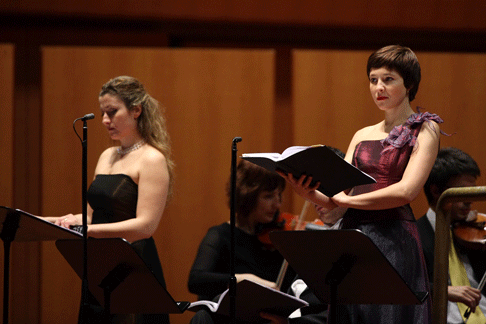
Haydn takes the opera as his model not only for the dialogical texture but also for the aria’s structure. Unlike the opera seria of the time, in which the involvement of the chorus is reserved for particularly festive types such as the Festa teatrale, in the Italianate oratorio both parts traditionally concluded with a chorus; usually the choir also played a part in the opening scene. Besides this, the inclusion of contrapuntal techniques is typical of oratorio. The basic question is still unanswered: it is an oratorio or a grand opera seria?
After performances in Vienna at the Kärtnertortheater in 1775 and in 1784 at the Hofburgtheater, where it was heard again in 1808 , Il ritorno di Tobia faded away until very recently. There only a couple of recording available - and not very easy to find and purchase.
Santa Cecilia’s lavish production is to be considered an Italian premiere. The symphony orchestra was superbly conducted by Flavio Biondi, the creator and leader of the Europa Galante ensemble. To borrow from Giuseppe Verdi one of his favorite quote Biondi “made the orchestra dance” . A few cuts were made in the very long score; I attended the Monday subscription performance starting at 9 pm. Even after the cut, the work, unknown to most of the audience, appeared too to some; at end (well after midnight) only half of the large auditorium (2800 seats) was full but those who sat through the end gave a generous applause to the orchestra, the chorus and the soloist.
The chorus deserves a special mention. There important and very difficult choral sections in Il ritorno di Tobia. They require considerable skills; conducted by Filipp Maria Bessan, the Santa Cecilia Chorus had a warm deserved applause.
Somewhat uneven the soloist cast. Maria Grazia Schiavo was an excellent Sara and gained an open stage applause after her long second act arias where her acute reached very high heights. An Allenberg is a alto specializing in baroque and XVIII century music; she was a very motherly Anne descending to very grave tonalities. Bernard Richter , Tobia,is a lyric tenor: he braved out a role requiring to climb very steep acute mountains. Less satisfactory Johannes Weisser , Tobit , and Valentina Farcas, Raffaele.
Giuseppe Pennisi
image=http://www.operatoday.com/IlRitorno2.gif imagedescription=Fabio Biondi
product=yes producttitle=F. J. Haydn: Il Ritorno Di Tobia productby=Orchestra e Coro dell’Accademia Nazionale di Santa Cecilia. Conductor: Fabio Biondi. Valentina Farcas (Raffaele); Maria Grazia Schiavo (Sara); Ann Hallenberg (Anna); Bernard Richter (Tobia); Johannes Weisser(Tobit). Chorus Master: Filippo Maria Bressan. product_id=Above: Fabio Biondi. Photos by Musacchio & Ianniello.
Zeffirelli’s New “Pagliacci” Without “Cav” But With Motorbikes
Leoncavallo never attained anything else remotely approaching the success of “Pagliacci”, though he wrote a dozen of other operas and operettas. “Pagliacci” is normally plaid in a double bill with Pietro Mascagni’s “Cavalleria Rusticana”, as they are both short and kindred in spirit. Artistically, the combination represents the apex of the Italian “veristic” movement; commercially the double bill constitutes a salable “ham and eggs” staple for many an opera house. The “Pagliacci”’s Prologue is considered the very “manifesto” of “verismo” aesthetics It is known that Mascagni never appreciated the idea of the double bill. Zeffirelli broadly agrees with him. Albeit he has staged “Cav” and “Pag” in several theatres , including the “Met”, and also directed a movie with the two operas, most recently he has produced different versions of “Pagliacci” either alone or with a ballet (to fill the evening; “Pagliacci” lasts 70 minutes). In the 1980s, for instance, in a La Scala production, Zeffirelli placed the plot during Italian fascism and completed the performance with the Nino Rota ballet “La Strada” (after Federico Fellini’s movie). In the 1990s, in Rome “Pag” was a stand-alone show; the plot was placed under a highway bridge or by-pass in Southern Italy. In this new production, “Pagliacci” is a blighted Neapolitan suburbs where motorbikes (“lambrettas”, but also high speed Japanese motos) cross the stage, prostitutes of all races sell their ware, drug pushers are in the crowd of nearly 200 (double chorus, children chorus, extras).
The show is grand and also elegant and with Zeffirelli’s usual care for details. There is a special feature in the staging : the first act is quasi-neorealistic (inspired by Rossellini and De Sica movies of the 1940s); the second act is fellinian (viz in an atmosphere of Fellini’s movies). A real touch of genius which shows how Leoncavallo, although assertive “verista”, was approaching visionary expressionistic lands.
There a very close entente with the musical director Gianluigi Gelmetti whose wand demonstrate how brilliant is the score (in spite of what some reviewers starte); the use of motif’s point to Wagner’s influence (also present in the Canio’s role), the melodies are subtle and well-judged, the orchestra is used with elegance and the choruses (in Rome under the guidance of Andrea Giorgi) well-polished. The Prologue is a real stroke of genius. Gelmetti underscored the rhythmic élan of the main theme whilst Zeffirelli had the curtain abruptly torn aside to carry the audience into the kaleidoscopic world of the strolling players. The perfect “unison” between director and conductor adds value to the agonizing sorrow when Canio (Stuart Neill) takes on the second main them , his desperate “Ridi, Pagliacci”. Finally, the Colombin play is performed as it should be : a self-contained musical jewel with dance-like style including Nedda-Colombina (Myrtà Papatanasiu) minuet, Taddeo (Seng-Yyun Ko) light hearted waltz tune and duet where the comic parody has as undertone the dramatic thematic accompanied from the same scene in the first act and the underlying seriousness is clearly suggested.
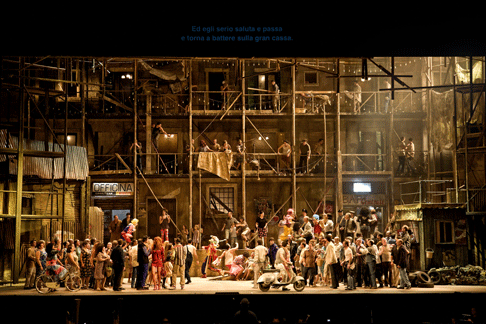
The orchestra responded very well to the challenge of giving a demonstration that “Pagliacci” is not a second class score for cheap summer performances by travelling companies moving from resort to resort but a XX century masterpiece. Stuart Neill is big generous American tenor with the voice to fill the huge Teatro dell’Opera; his timbre is very clear and his acting better suited to Canio than to La Scala recent “Don Carlo” Myrtà Papatanasiu is a good soprano with a very nice voice emission but lacks the volume required by the Teatro dell’Opera. Effectuive Seng-Yyun Ko and the other.
The audience was thrilled as shown by the many curtain calls
Giuseppe Pennisi
image=http://www.operatoday.com/pagliacci4.gif image_description=Scene from Pagliacci [Photo by Marco Serri]
product=yes producttitle=Zeffirelli’s New “Pagliacci” Witout “Cav” But With Motorbikes productby=Nedda: Myrtò Papatanasiu (19, 21, 24, 27) / Susanna Branchini (20, 23, 26) / Mina Yamazaki (22); Canio: Stuart Neill (19, 21, 23, 24, 26) / Renzo Zulian (20, 22, 27); Tonio: Seng-Hyoun Ko (19, 21, 23, 26) / Silvio Zanon (20, 22, 24, 27); Silvio: Domenico Balzani (19, 21, 24) / Pierluigi Dilengite (20, 23, 26) / Gianpiero Ruggeri (22, 27); Peppe: Danilo Formaggia (19, 21, 23, 26, 27) / Cristiano Olivieri (20, 22, 24); A Farmer: Giordano Massaro (19, 21, 23, 26) / Vinicio Cecere (20, 22, 24, 27); A Second Farmer: Antonio Taschini (19, 21, 23, 26) / Andrea Buratti (20, 22, 24, 27). Condustor: Gianluigi Gelmetti. Chorus Master: Andrea Giorgi. Stage director and set designer: Franco Zeffirelli. Costumes: Raimonda Gaetani. Lighting: Agostino Angelini. Orchestra and Chorus of Teatro Dell’Opera. product_id=Photos by Marco Serri
An Elegant Pique Dame in Turin
The work’s forces include 14 soloists, a chorus of some 100 men and women, a children chorus of 24 and a “theatre-within-the-theatre” pastoral pantomime with the arrival of Empress Katherine the Great and her retinue. Its three acts entail seven different scenes: from St. Petersburg’s gardens in the spring to the great hall of a palace, to private apartments, to the banks of the Neva, to officers’ quarters, and finally, to the casino. Turin had had only one fully staged series of seven performances (but in Italian and with substantial cuts) way back in 1963. There had been concert versions (in Russian) in the RAI Auditorium (the most recent in 1990). The Teatro Regio is a well-managed institution; it has scheduled a glittering new production for the current season with the intent to rent it to other Theaters; its normal partners are Lyon’ s and Los Angeles’ opera houses. A star of the Russian opera theaters, Dmitri Cherniakov, entrusted the stage direction and stage set. Another star (Misha Didyk) was contracted for the taxing role of the protagonist, Herman. Finances compelled cuts of the expected lavish production.
Meanwhile, both Cherniakov and Didyk disappeared or, rather, vanished away. The Regio Musical’s strong-willed director, Gianandrea Noseda, conducted. Denis Krief was called upon to provide a “low cost, but elegant” production that would set a standard for low budget productions that could nevertheless be leased to other theaters. The Teatro Regio gave Krief three days to develop a new concept for this “Pique Dame” staging.
The resulting production consisted of a single set with the stage floor as a huge gambling table where, with a few simple props, the gardens, the palaces, the apartments, the barracks, the casinos take shape. In “Pique Dame”, Tchaikovsky delved into his own personal problems (foremost his sexual orientation) that three years later led him to commit suicide (the most widely accepted version of his death). He used the 18th Century setting as a device that allowed the examination of himself and of contemporary Russian aristocratic and bourgeois society (similar to Strauss’ “Der Rosenkavalier”). In this context, the setting was moved forward to the end of the 19th Century.
![562_[0175]_DPant.gif](http://www.operatoday.com/562_%5B0175%5D_DPant.gif)
Black and white is de rigueur — a spectral ghost society now in decay. Within this context, the Countess is not a handicapped old woman, but an aging, yet still attractive, “grande dame”. Hermann is not in love with Liza — she is a mere tool to enter the Countess’ bedroom and steal the secret of the winning three card combination — but is struggling with his own obsessions. Prince Eleckij, on the other hand, is a real man suffering from Liza’s betrayal. The others (Polina, Count Tomskij, Celakinskij, Surin, Narunov) represent Russia in decay. The gambling casino resembles a cemetery.
The Regio audience saluted the staging (and the rest of the performance) with standing ovations. Some reviewers appreciated the musical part but regretted the lack of cardboard 18th Century palaces and wigs.
![562_[0282b]_DPant.gif](http://www.operatoday.com/562_%5B0282b%5D_DPant.gif)
The young and attractive Russian tenor, Maksim Aksënov, rescued what threatened to become a doomed production. A superb actor, Aksënov has a crystal- clear timbre. He easily reaches high “Cs” and caresses tender “legatos”. He has a great career in front of him; but he has work to do on the central tonalities and on the “mezza-voce”.
There were two vocal and acting giants with him. Svetla Vassileva is more at ease with Tchaikovsky than with the Verdi repertoire in which she is normally cast in Italian opera houses. Anja Silja, with a career of more than 55 years, remains impressive.
Gianandrea Noseda has a dry way of conducting this score- different from Gergeev’s dramatic nearly violent approach, from Tchakarov’s morbid treatment and from Jurosvkij’s emphasis on anticipations of the 20th Century. The orchestra responds well, especially the strings and the woods. The double chorus has some difficulties with Russian pronunciation.
Altogether, this production deserves to be seen elsewhere in Europe and, perhaps, in the USA.
Giuseppe Pennisi
image=http://www.operatoday.com/content/tchaikovsky.gif image_description=
product=yes producttitle=P. Tchaikovsky: Pique Dame productby=Hermann: Maksim Aksënov; Liza: Svetla Vassileva; The Countess: Anja Silja; Eleckij: Dalibor Janis; Polina: Julia Gerteva; Tomkij: Vladimir Vaneev. Musical director: Gianandrea Noseda. Stage director, set and lighting: Denis Krief. Chorus Master: Roberto Gabbiani.
May 25, 2009
Italian Opera on the Road
The weeks after the end of the winter and spring “seasons” and at the start of the summer festivals are those when the Italian opera houses are in a better financial position to tour abroad. Opera-goers abroad can see, and assess, opera as the Italians do it. Four of the 12 major opera houses are in dire financial straits. Although the tours normally pay for themselves and bring home a net profit, their artistic programs are inadequate to make them reliable partners of foreign houses and impresarios.
There is a strong demand for Italian opera staged and sang by Italians, especially in the Far East. I remember Donizetti’s Roberto Devereux staged in a Seoul movie house in 1973. While the staging was elementary, the Korean cast and singers were up to good standards. Recently I arranged a tour of the Teatro Lirico Sperimentale di Spoleto to ten Provincial Capitals of Japan, which included 17 performances of Traviata based on the 1953 La Fenice production designed by Nicola Benois for Maria Callas. It helped fill a hole in our accounts.
Asia is again the area to where the best Italian companies are heading. In the recently built Beijing National Center for Performing Arts — a modern house for an audience of 2000 — La Fenice brings a new glittering production of Madama Butterfly in the latter part of May. And Il Regio di Parma brings a juicy Rigoletto — a perfect “old style” grand staging originally created by Pierluigi Samaritani and updated by Stefano Vizioli.
La Scala will be at the center of attention of Japanese opera-goers in early September with two disparate productions of recent vintage. These are Zeffirelli’s colossal Aida (premiered in the 2006-2007 season) and Braunschwieg ‘s controversial Don Carlo (premiered in the 2008-2009 season). Spoleto Lirico Sperimentale will tour Japan in September.
No major company plans to the tour the US this year. However, the up-and-coming Orchestra Sinfonica-Fondazione Roma (the only private symphony orchestra in Italy) plans to tour the US in January 2010.
This July the well-run Teatro Massimo di Palermo will be at the Savonlinna Festival in a Finnish Middle Age Castle surrounded by forests and lakes — a real “must” for our Nordic readers. It will show a magnificent new production of I puritani (already performed in Palermo and Bologna and scheduled for next year in Cagliari and Beijing). Teatro Massimo has also scheduled the traditional double bill Cav/Pag.
The Parma Regio starts its program abroad in late May in Wiesbaden with the innovative production of Nabucco unveiled at the October 2008 Verdi Festival.
Giuseppe Pennisi
image=http://www.operatoday.com/LaFenice.gif imagedescription=La Fenice
product=yes product_title=Italian Opera on the Road
May 24, 2009
Michael Volle’s intriguing Dr Schön, in the Royal Opera House’s new Lulu.
Michael Volle is singing Dr Schön in the new production. The role is critical, for Dr Schön has known Lulu most of her life. He rescued her from the streets and is a kind of father figure with whom she is obsessed. Yet, once she has him, he’s destroyed. “This music is difficult the first time you hear it”, says Volle, “but after these rehearsals, I’ve discovered its beauty”. Volle is extremely experienced, but this is the first time he’s created the role. “I knew it would be interesting to do it with Christof Loy”, he adds. He’s worked with Loy before. In 2008, he sang Pentheus in Hans Werner Henze’s monumental Die Bassariden, directed by Loy, in Munich.
“It was marvellous”, he adds. “I knew he would not do anything conventional but that he would try and get into the characters and find the key to their personality”. Loy’s does this by working closely with the singers from the start. “We talk a lot about the role. He tells you his thoughts about the background and what he imagines the character is like and then you have to find a away to express it. He is one of those directors who knows and loves the music so well that he can make it easy for a singer to find his way into a character. He doesn’t try anything artificial you can’t understand. It’s more like putting flesh and bones on the score”.
Dr Schön is a mighty business magnate. He seems so solid and secure, yet inside there’s something vulnerable. He ends up humiliated by Lulu, who kills him. “All over the world, there are men who have power in society like this. But they aren’t fulfilled if they don’t have something in their private lives that keeps them strong. Dr Schön doesn’t have that, so he’s vulnerable”. Ironically, he might have escaped Lulu if he hadn’t spared her from being arrested for stealing from him when she was a child. It was he who arranged for her to marry the wealthy Dr Goll, and he who made the Painter rich by buying his paintings.
“There are productions where there are a lot of sexual things on stage”, says Volle, implying that Dr Schön’s motives are simply erotic, for men (and women) lust after Lulu. But in this production, it’s more complex. “Only one kiss”, says Vollle, and a few bits of touching. There’s no need to show nudity and violence. It’s shocking how much violence there is in it anyway”. Suicide, murder, implied paedophilia, and Lulu seducing Alwa on the very sofa his father bled to death upon, all easy subjects to play up to scandalize an audience. Yet Loy’s approach is not sensational for sensation’s sake. “What I like about Loy’s work is that he does not do Yellow Press”.
“It’s very tragic. Terrible things have happened to Lulu in the past, and it’s affected her so she can’t trust anyone, or be content”, says Volle, explaining the psychology behind this production. “She must always destroy the happiness of others ”. Lulu wrecks Dr Schön’s engagement but she’s unhappy when she marries him herself. “She loses interest because she doesn’t have to fight for attention anymore. In this production that tragedy is made very clear. There are lines which show Lulu does have feelings for Dr Schön, but she’s damaged, and hurts others because she’s been hurt so much herself”.
Volle is also happy with the Royal Opera House production because it’s being developed so closely with the conductor, Antonio Pappano. “He is a gift”, says Volle, “He was there at the first rehearsal, and he knows the piece inside and out. He gives so much input and ideas about the music”. With Berg, details count. “The more you hear in it, the more you discover”, says Volle. This is significant, as Volle knows Berg’s idiom well, having sung the title role in Wozzeck.
“Tony says Lulu is closely connected to Vienna. There are so many dances, waltzes, gavottes, which might not be obvious at first, but you can hear wonderful things in it, even in the piano rehearsals”. With full orchestra, it should be impressive, given Pappano’s affinity with the opera.
This Lulu will be performed in the three act version, completed by Friedrich Cerha in 1979. The deceased Dr Schön returns as Jack the Ripper and kills Lulu when she, in her turn has been humiliated and reduced to prostitution. It creates symmetry in the drama, but it’s frustrating to sing after a break of 2½ hours after Dr Schön’s death. “When I get going, I want to keep singing”, says Volle. “It’s a bit like Amfortas in Parsifal”, which Volle sang with Haitink conducting, when he was at Zurich Opera, “but the character is very different”.
This new production is interesting because it has insights on how Lulu came to be who she was, and on the way people react to her. Dr Schön can’t stand up to her because he doesn’t have an anchor in his own past. Michael Volle’s background is rooted in solid values. His father was a pastor, his family was large and close. They were poor but that wasn’t necessarily a disadvantage. When people make a lot of money easily, the temptation is to live unwisely, but from his childhood, Volle learned the true meaning of the motto “less is more”.
So much opera is about creating convincing roles with depth of character, so having good basic values helps professionally, too. “I feel that the more I have with me inside, the more I can give. There is more to singing than just technique. It’s nice to do technically difficult singing, but for me, there has to be more expression, more depth”.
Volle grew up singing Bach, Schütz and Handel. “I must have Bach in my life”, he says, “I love every Passion, and cantatas, oratorios, even chamber music with no singing involved. It’s my lifeblood, I need it”. It is not about religion as an institution, but an expression of a more fundamental spirituality. “Bach is not a composer like any others”, says Volle. “Like Mozart, he creates something wonderful you can’t describe, like clean, open skies, like Paradise. “Everyone has different tastes, of course, but for me there is more in the last wonderful moments of Le Nozze di Figaro, or a few passages from Bach, than in whole works of other kinds. I will go on singing Bach to the end of my singing days, it’s so healthy”.
“You must engage with Lulu, you cannot only sit and lean back” , he says of the new production at the Royal Opera House. The cast is particularly strong. Lulu is Agneta Eichenholz, who has worked with Christof Loy before : word has it that she’s very good. This Lulu is psychologically intense, and sometimes, as Volle puts it “if you get too close to a part there are inner strings which get put into motion”. Volle has sung a lot of material like Wagner, and demanding roles like Don Giovanni and Graf Tamare in Schreker’s Die Gezeichneten (in the superb production from Salzburg), but given his background, he’s mature enough to create a good Dr Schön without having to “be” him. “There’s definitely not, I hope any Jack the Ripper in me”!
Anne Ozorio
Lulu runs at the Royal Opera House, London from June 4th to 20th 2009. The cast includes Agneta Eichenholz as Lulu, Michael Volle as Dr Schön/Jack the Ripper, Jennifer Larmore as Countesss Geschwitz, Klaus Florian Vogt as Alwa, Gwynne Howell as Schigolch, Philip Langridge as The Prince/Manservant/Marquis, Peter Rose as Animal Trainer/Rodrigo, Heather Shipp as Dresser/Gymnast/Groom, Frances McCafferty as Mother and Will Hartmann as Painter/Negro. Christof Loy directs, and Antonio Pappano conducts the Royal Opera House Orchestra.
image=http://www.operatoday.com/Volle.gif image_description=Michael Volle [Photo by Anne Kirchbach]
product=yes producttitle=Michael Volle’s intriguing Dr Schön, in the Royal Opera House’s new Lulu. productby=Above: Michael Volle [Photo by Anne Kirchbach]
May 22, 2009
Norma by English Touring Opera
The Norma was Yvonne Howard, a career mezzo whose recent forays into the soprano repertoire (notably, Leonore for Opera Holland Park and Lady Macbeth for Opera North) have been proving consistently successful. She undoubtedly sounds more soprano than mezzo these days, her voice brighter-hued than that of the Adalgisa, Alwyn Mellor, and her top notes easily produced and fully integrated with the rest of her voice. Though both women acquitted themselves admirably, it’s always difficult to ensure an adequate contrast between the two voices, and with this cast it didn’t come off; Mellor is a soprano, but a dark-toned, weighty one, and without knowing the plot it would have been impossible to tell which of the two women was meant to be the younger.
Under the baton of Michael Rosewell, Bellini’s score sounded classy, the four-square rhythms of the choruses crisp and poised, and the legato of the female-voice numbers elegant. The acoustic of Cadogan Hall has the benefit of making small forces sound full-bodied and substantial; I need not have worried about the volume limitations of an 18-strong chorus and an orchestra of fewer than 40. At the same time, solo voices can also carry well here, with Howard’s beautifully contained pianissimo in ‘Casta diva’ set off by the subtle orchestral texture. And the hall gives an immediacy to the opera’s more intimate dialogues, especially those between the two women; the soft opening section of ‘Mira, o Norma’ felt as though the audience were intruding upon a very private moment. One wonders whether the conversational style of the duets came across quite so powerfully at the tour’s larger venues, which included Exeter Cathedral.
Elsewhere the balance was more problematic, with the chorus tenors drowning out the women’s voices, and an excess of bassy orchestral sound threatening to overwhelm the tenor Justin Lavender in Pollione’s opening aria. Lavender was somewhat wooden and he failed to give the vocal line much shape; Piotr Lempa’s Oroveso was vocally adequate but rather stiff and characterless.
Considering the musical intimacy between the female voices, it was a shame that the opera was given in such strict ‘concert’ fashion. Though entrances and exits were made as necessary in a cursory step towards being semi-staged, the duetting singers always facing straight ahead and barely exchanging glances with one another.
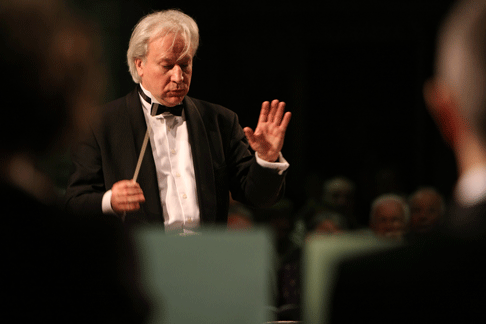 Michael Rosewell [Photo courtesy of English Touring Opera]
Michael Rosewell [Photo courtesy of English Touring Opera]
The roles of Flavio and Clotilde were satisfactorily taken by Charne Rochford and Helen Johnson, who doubled as members of the chorus.
Onto the autumn, and ETO’s next project - in celebration both of its own anniversary and of Handel’s — will be the staging of five different Handel operas, in a tour which commences in October at the Britten Theatre at the Royal College of Music.
Ruth Elleson © 2009
image=http://www.operatoday.com/ETO0104081637881.gif imagedescription=Yvonne Howard [Photo courtesy of English Touring Opera]
product=yes producttitle=Vincenzo Bellini: Norma productby=Norma: Yvonne Howard; Adalgisa: Alwyn Mellor; Pollione: Justin Lavender. Conductor: Michael Rosewell. English Touring Opera. Cadogan Hall, London product_id=Above: Yvonne Howard as Norma [Photo courtesy of English Touring Opera]
Don Carlos — Opera North, Leeds
In the interests of context I would always favour five acts, not only for the background to Carlos’s meeting with Elisabeth, but for a fuller introduction to the character of Elisabeth who can be reduced almost to a cipher in the shorter version. But the four-act version is the tauter piece, and in the right hands has the potential to create the greater dramatic impact.
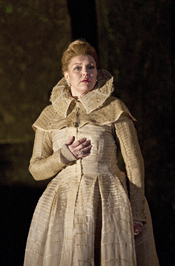 Janice Watson as Elisabeth
Janice Watson as Elisabeth
Hildegard Bechtler’s sets are austere and claustrophobic, the stage dominated by vast stone walls; even the sun-filled garden outside the cloister is hemmed in and inescapable. When the stage is dark, it is really dark: in the opening and closing scenes at San Giuste, there are times when unmoving figures are barely discernible. A pale grey curtain with a square aperture allows every scene to begin with a framed ‘thumbnail’, a trick which proves effective in clarifying and distilling each dramatic situation. Although the frequent and prolonged scene changes (the vast walls take some time to reconfigure) break up the pace somewhat, the intensity of each scene was such that I welcomed the opportunity to recover. Nothing here is empty spectacle - it is all cleanly focused, and there is no fat on the bones.
There was one particular bone upon which a little more fat would have been welcome. While the theatre’s superb acoustic enhances the volume of the orchestra and soloists, the start of the auto-da-fé scene should be a grand ensemble, and Opera North’s chorus simply sounded as if they would have benefited from a few more extras.
Julian Gavin sang the title role in the 1998 revival, and 11 years on he is no less credible as the young prince. His voice still has that urgent quality which captures Carlos’s angst, but now it’s combined with an open-throated evenness of tone which is really exciting to listen to.
From the start, Brindley Sherratt’s Philip II always seems rather cowed by the burden of responsibility, pale-faced and worn in the plain black costume which makes him look rather small and all too human. His dryish bass, too, captures well a disillusioned monarch who is comparatively easily overcome by the Grand Inquisitor - Clive Bayley, another returner from the 1998 revival, doesn’t really have the deep bass weight one might ideally wish for, but he projects real menace in his bearing.
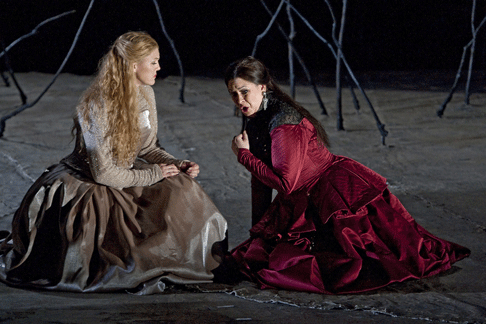 Janice Watson as Elisabeth [left] and Jane Dutton as Eboli [right]
Janice Watson as Elisabeth [left] and Jane Dutton as Eboli [right]
In her company debut, Janice Watson was a graceful and dignified Elisabeth. Not a natural Verdian, she sang very beautifully up until the last act, but was running out of steam during her aria and struggled to maintain the line in her subsequent duet with Carlos. William Dazeley was hugely impressive as Posa - he is unquestionably slightly on the light side, but he has an intelligent command of the music and is entirely convincing in this role which is so central to the opera. Jane Dutton’s Eboli was alluring and magnetic, with visceral power in ‘O don fatale’.
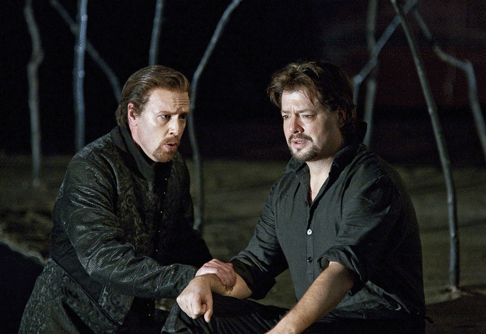 William Dazeley as Rodrigo [left] and Julian Gavin as Don Carlos [right]
William Dazeley as Rodrigo [left] and Julian Gavin as Don Carlos [right]
Particularly impressive among the smaller roles was the monk of Robert Winslade Anderson, a dark-toned and focussed young bass who is surely a Philip-in-waiting. Julia Sporsén was a pert and courtly Thibault, and chorus member Kathryn McGuckin was a lyrical and secure Voice from Heaven, standing in for Rebecca Ryan (who, thanks to a visa problem, was stuck on the other side of the world).
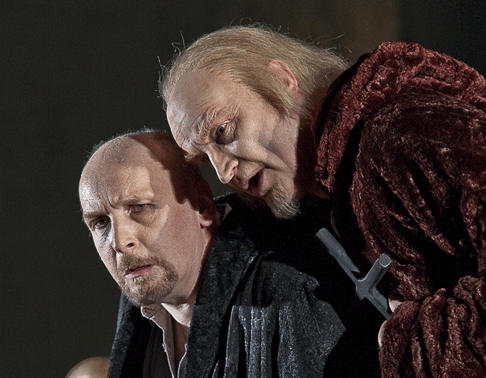 Brindley Sherratt at King Philip II [left] and Clive Bayley as The Grand Inquisitor [right]
Brindley Sherratt at King Philip II [left] and Clive Bayley as The Grand Inquisitor [right]
Conductor Richard Farnes really has the measure of the piece, throwing the score’s many bursts of passion or urgency into relief against the measured pace of the more intimate moments of intrigue. The word-setting in Andrew Porter’s superior translation is intelligent and natural-sounding, and it is delivered with clarity by every member of the cast. A recording is imminent in the Chandos Opera in English series, with most of the same performers; a welcome opportunity to keep for posterity a performance which presents as strong an argument for Verdi in English as we are ever likely to hear.
Ruth Elleson © 2009
image=http://www.operatoday.com/Don-Carlos01.gif image_description=Julian Gavin as Don Carlos [Photo by Clive Barda courtesy of Opera North]
product=yes
producttitle=G. Verdi: Don Carlos
productby=Don Carlos: Julian Gavin; Elisabeth: Janice Watson (ex 17, 20, 24 June), Susannah Glanville (17, 20, 24 June); Monk: Robert Winslade Anderson; Rodrigo: William Dazeley; King Philip: Robert Winslade Anderson (13 May), Alastair Miles (23 May; 3, 13, 17, 20, 24 June); Eboli: Jane Dutton; Thibault: Julia Sporsén; Grand Inquisitor: Clive Bayley. Conductor: Richard Farnes. Director: Tim Albery. Set Designer: Hildegard Bechtler. Original Costume Designer: Nicky Gillibrand.
product_id=Above: Julian Gavin as Don Carlos
All photos by Clive Barda courtesy of Opera North
May 21, 2009
Lieder and Opera meet in Hugo Wolf
The Wigmore Hall is hallowed ground for Lieder. Built in 1901 for Bechstein, it is one of the world’s great recital halls, where many great singers have appeared, even though it seats only 450. It’s the ambience that draws them. They’d make more money in a big arena, but the Wigmore Hall is a special experience. It’s small enough that interaction between performers and audience is direct and intimate. This is the ethos that makes Lieder so special. It’s intensely personal and nuanced : song through a microscope to speak, but imbued with warmth and feeling.
Christian Gerhaher is a favourite with the Wigmore Hall audience. On this evening Anna Netrebko and Dimitri Hvorotovsky were scheduled to sing elsewhere in town, impacting on sales, so the Wigmore Hall wasn’t sold out as usual. Gerhaher was singing Hugo Wolf’s Italienisches Liederbuch, with his regular pianist, Gerold Huber and a young soprano, Mojca Erdmann.
The 46 songs in the collection form a narrative, or even a cycle. Together, they form a kaleidoscope of “Italian” life, romanticized through Austro-German ears.. Hugo Wolf never fulfilled his dream of going to Italy, but each song is full of vividly imagined incident. Dissolute monks seduce girls whose mothers trust men in robes, a girl longs for “older men” – aged 14!. Each song is like a moment in a larger story. Der schöne Toni’s eating himself to death because Tonina has dumped him, and a man’s heart jumps clean out of his chest, running off to see his lover.
Plenty of drama, then, in these songs, which Wolf plays up exuberantly with witty piano commentary. They lend themselves to more dramatic treatment than do more introspective Lieder. Indeed, much of the impact would be lost if they were performed without a lively sense of fun.
Gerhaher was in good form. His voice is richly resonant, yet flexible enough that he takes Wolf’s tricky rhythms with ease. Yet these songs are still fundamentally, Lieder, where the action is inward. Gerhaher was most impressive in songs where the singer has to hint at deeper mysteries. For example, Schon streck’t ich aus im Bett, where the lover jumps out of bed to play his lute. Wolf sets the last stanzas with a strange, meandering lilt which evokes the strumming of the lute but also the text which pointedly mentions that the singers has walked away from many girls, his music “wafted away in the wind”. It’s no serenade.
Lieder is private, almost silent expression. There’s no orchestra, set or plot to compete with, so the dynamics are different. Mojca Erdmann is young, who’s still having to prove herself with her voice, so naturally she’s more inclined to a declamatory approach that highlights the technical side of her singing. Her flourishes in ‘Ich hab’ in Penna’ would sound impressive in the theatre, but overwhelm the balance in the song. True, the song’s about a girl bragging about her many admirers, but it’s more effective with a touch of subtlety.
As the first song in the set goes, ‘Auch kleine Dinge’, “even small things can delight”. “Think only of the rose”, it continues in delicate tones, “it’s small but smells sweet”.
Anne Ozorio
image=http://www.operatoday.com/wolf.gif image_description=Hugo Wolf product=yes product_title=Hugo Wolf : Italienisches Liederbuch — Wigmore Hall, London product_by=Christian Gerhaher (baritone), Mojca Erdmann (soprano), Gerold Huber (piano)Wolfgang Amadeus Mozart Lieder, Salzburg 1958-1984.
In a two-CD set, it is possible to gain a perspective on these periodic recitals. Starting with the 1958 Festspiel, the recording captures Irmgard Seefried accompanied by Erik Werba, with some of the composer’s representative Lieder. This follows with music from a decade later in 1968 with Ingeborg Hallstein, again with Werba. The other performances follow in quicker succession: 1975’s Liederabend with Peter Schreier accompanied by Jörg Demus and Helen Donath with her pianist husband Klaus; in 1983, Edith Mathis with Heinz Medjimorec, piano; 1984, Edita Gruberova, soprano, and Irwin Gage piano; and in addition, Walter Berry sang Mozart’s Kleine deutsche Kantate, KV 619, with Werba accompanying him. (Gruberova also performed this work in her 1984 Liederabend.) All in all, this set of documents some of the finest exponents of Lieder of the time in performances, as underscored by the rubric on the discs, “Grosse Mozartsänger” (“Great Mozart singers”).
Some of the music is familiar, as with “Das Veilchen,” KV 476, which was part of several recitals, and it is possible to compare the performances by sopranos Hallstein and Gruberova, and enjoy the piece from the tenor Schreier. All three singers offer fine readings of this piece, and it is fortunate to have both in a retrospective collection like this one. Other pieces are not as widely known, as with “Der Zauberer,” KV 472, which Donath and Mathis included in their recitals, or “An Chloe,” KV 524, as performed by Seefried and, later, by Schreier. While most of the songs are indeed Lieder, Schreier, Mathis and Gruberova include several of Mozart’s chansons, such as the Ariette KV 308 “Dans un bois solitaire” (which Schreier renders in German translation and Mathis sings in French) or the Italian canzone “Un moto di gioia,” KV 579, which was part of Seefried’s and Gruberova’s programs. All in all, the collection not only preserves the works of these fine singers, but also offers a fine introduction to the solo vocal music of Mozart.
The performances are generally fine, and it is useful to hear multiple performances of the same pieces to gain a sense of the range of interpretation possible within this part of Mozart’s repertoire. The vibrant approach of Peter Schreier conveys a wonderful engagement with the music as found in the nuances of dynamic within the phrases, as the tenor uses in his performance of “An Chloe.” His effortless approach to higher range matches the control apparent in Schreier’s lower pitches. When compared to other singers singing this literature, Matthis seems more passionate in her interpretations, which are solid and convincing. The performances by Gruberova also merit attention, and her interaction with Irwin Gage demonstrates the way in which these pieces demand the attention such a pianist brings to their execution.
The sound of some examples, as with those of Irmgard Seefried, resembles studio recordings, while others, like those of Ingeborg Hallstein include some audience sounds including, at times, applause. Throughout these recordings, the balance between voice and accompaniment is generally good, with some recitals betraying a more aggressive accompanist, others with the singers placed closer to the microphone, as with Schreier. While some details may be easier to hear in the later recordings, like those of Gruberova from 1984, the quality is uniformly high.
In terms of the set itself, it is useful to have the full text and translations keyed to the tracks. In fact, Orfeo was good to use a single text when pieces are repeated and to include the listing of the tracks in which they also occur. At times the German is rendered differently than found in the music or, in some cases, sung, and those seeking English translations of the song texts will not find them in this rather slim booklet. Nevertheless, the concept behind the recording and, more importantly, the legacy it represents, is honored well in the selection of the pieces by some of the finest exponents of Lieder from the latter part of the twentieth century.
James L. Zychowicz
image=http://www.operatoday.com/MozartLiederSalzburg.gif image_description=Wolfgang Amadeus Mozart Lieder, Salzburg 1958-1984
product=yes producttitle=Wolfgang Amadeus Mozart Lieder, Salzburg 1958-1984 productby=Irmgard Seefried, Igenborg Hallstein, Helen Donath, Peter Schreier, Walter Berry, Edith Mathis, Edita Gruberova. productid=Orfeo d’or 709062 [2CDs] price=$36.99 producturl=http://www.arkivmusic.com/classical/Drilldown?nameid1=8429&namerole1=1&compid=1932&genre=134&bcorder=195&nameid=15069&name_role=2
New Boss in Salzburg
Frank Cadenhead [Figaro Si, 21 May 2009]
Alexander Pereira, currently director of the Zurich Opera, has been named as the new artistic director of the Salzburg Festival from October 1, 2011. The 61-year-old Vienna native will succeed current intendant for a five year term, which will be normally renewed.
May 20, 2009
Bryn Terfel Gives Advice to BBC Cardiff Singer of World Competitors
That was the opportunity for three of the singers representing their countries in BBC Cardiff Singer of the World in June who were able to enjoy some pearls of wisdom from Bryn.
The world famous Welsh singer took time out to meet the young singers at the Royal Opera House, Covent Garden, scene of many of his triumphs.
Bryn took part in the Cardiff competition 20 years ago and won the Lieder Prize (now the Song Prize). He had only weeks before won the Gold Medal at the Guildhall School of Music and Drama in London.
Bryn met Natalya Romaniw from Swansea who this year follows in his footsteps, representing Wales in the BBC Cardiff Singer of the World straight from being a student at the Guildhall.
He also chatted with this year’s Japanese contestant Eri Nakamura and the Korean contestant Ji-Min Park, both of whom are members of the Jette Parker Young Artists Programme at the Royal Opera House.
Bryn, who last sang Der fliegende Holländer at the Royal Opera and returns in July to sing Scarpia in Tosca, told them; “Remember that your performance starts the moment you walk on to that stage so have a big smile on your face.”
Keep hydrated was his “top tip”. “You will be doing so many rehearsals, interviews and then the performances just keep on drinking water, keep it in your bag and drink it whenever you can.”
Eri appears at St David’s Hall in the concert round on Sunday, June 7; Ji-Min on Monday, June 8 while Natalya makes her claim for the title of BBC Cardiff Singer of the World on Wednesday, June 10. The final is on Sunday, June 14.
All three are also taking part in the BBC Cardiff Singer of the World Song Prize is also held that week at the city’s New Theatre with its own final at ST David’s Hall on Saturday, June 13.
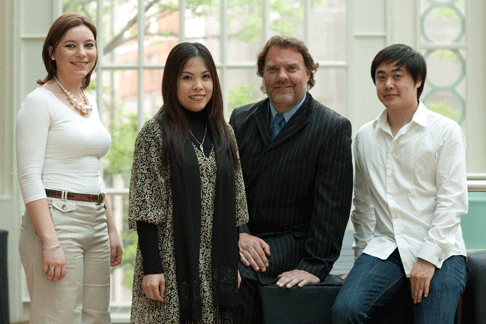 (l-r) Natalya Romaniw, Eri Nakamura, Bryn Terfel and Ji-Min Park [Photo by Brian Tarr]
(l-r) Natalya Romaniw, Eri Nakamura, Bryn Terfel and Ji-Min Park [Photo by Brian Tarr]
Although Bryn quickly rose to international stardom he did not win that coveted BBC Cardiff Singer of the World title but did take the Lieder Prize (now the Song Prize).
“I had never won anything at college,” Bryn said. “I tried jazz and Gilbert and Sullivan, English songs and nothing! But then I won the Gold Medal! Cardiff Singer was the first time I had sung with an orchestra.
“I told the singers you must enjoy the competition and, yes, it is important but you still have to do your auditions, sing to conductors. But it is a great platform to be given the chance to make yourself know to these people before you do have to take those auditions.”
After meeting Bryn, Natalya said, “It is really busy now. I have a table of how many days are left! I have my final recital at the Guildhall on May 28 which is part of my degree and then I finish. In the recital I am incorporating songs from the Competition so it will be kind of like a mock run.”
Ji-Min from Seoul was performing in Lohengrin at the Royal Opera that evening but said he did not want to miss the chance to meet one of his heroes. “It is one of my dreams to sing in BBC Cardiff Singer of the World. I bought a DVD of the competition and I listen to hit hundreds of times and listen it every day,” he said.
Eri from Kagoshima is in the first year of the Young Artists Programme and sings in L’Esire d’amore at Covent Garden before setting her sights on the Competition. “Before coming to London I was in the Opera Studio in Amsterdam and my colleagues there were talking about this competition and I checked the website and when I got contract here in London I decided to try. It is exciting to go to another city because I am always here in London.”
BBC Cardiff Singer of the World, June 6 to 14. Tickets from New Theatre, Cardiff: 029 2087 8889, St David’s Hall, Cardiff 029 2087 8444 or online at www.stdavidshall.co.uk
image=http://www.operatoday.com/BrynTerfel.gif imagedescription=Bryn Terfel [Photo by Harlequin Agency Limited]
product=yes producttitle=Bryn Terfel Gives Advice to BBC Cardiff Singer of World Competitors productby=Above: Bryn Terfel [Photo by Harlequin Agency Limited]
May 18, 2009
Anthony Michaels-Moore — from the army to the world stage.
He made his name singing Verdi, so Donizetti is a refreshing change. “I tend to play dark, obsessive characters”, he says, “but L’Elisir is fun and happy, so I can loosen up and really have a go playing up the ridiculous parts of the character”. Loosening up is a good word to choose. Michaels-Moore is so experienced that he no longer has to prove anything, so he can give Belcore an ease that brightens the role. He sang the part early in his career, reprising it more recently in Vienna and Barcelona. Soon he’ll be recording a CD of arias, with more Donizetti, Mozart and Tosti.
His next big project will be something entirely new. It’s a new opera, to be premiered at Santa Fe in September. It’s The Letter, based on the story by Somerset Maugham. In the 1930’s Bette Davis starred in the iconic film adaptation, though Hollywood had to censor the racier aspects of the plot. The music is by Paul Moravec. The librettist is Terry Teachout, the opera aficionado and music writer.
Moravec has written a lot of orchestral and chamber music but this is his first opera, and he wanted to involve his singers from the start. Michaels-Moore, who sings regularly at the Met) met the composer in New York, who asked him what he particularly liked in the music he sang “Right !”, said Moravec, “we’ll do it that way”. Because he writes with the singers, details can be tweaked and adapted, even in rehearsal. It’s very creative. Moravec also consulted Patricia Racette, who will sing Leslie Crosbie, the scheming wife. The result is an opera which “sings” well, and is user-friendly in performance. This could make it a regular part of the repertoire.
The plot of The Letter is complicated, full of intrigue. Michaels-Moore plays James Crosbie, the husband who doesn’t know he’s being deceived. The music starts out tenderly romantic, but soon develops an edge as Crosbie begins to find out what his wife is up to. Then there’s a mysterious death. The score has been pared down to flow fluidly to intensify the dramatic pace. It runs around 85 minutes, concentrated in one act and eight fast paced scenes.
The opera is set in tropical Malaya in the 1930’s, and the characters are stylish colonials. Costumes will be by Tom Ford, the designer, so expect beautiful cream linen and crisp cotton. This could be a visual treat. Direction is by Jonathan Kent.
Michaels-Moore is perhaps a natural for The Letter, as he started his career as a commissioned officer in the British Army. He went to Sandhurst and served in a tank regiment in Germany. Status and stability would have been assured. But his love for music was so strong that he quit the army, opting for the risky life of a singer. It must have taken courage and strength of personality. The army made him refund all they’d paid him over the years (he went to University on the British equivalent of ROTC) so he had to work as a teacher in Crowhurst until he was able to join the prestigious postgraduate opera course at the Royal Scottish Academy of Music and Drama.
His breakthrough came when he won the Pavarotti International Voice Competition in 1985, the first British singer to do so. Since then, he’s performed regularly with the Royal Opera House in London, where he has appeared in L’Elisir d’amore, La Bohème, I Pagliacci (Silvio), Die Fledermaus, Il Barbiere di Siviglia, Cunning Little Vixen, Massenet’s Manon, Stiffelio, Tosca, Simon Boccanegra in concert, Macbeth, Le Nozze di Figaro, Andrea Chénier, La Battaglia di Legnano, Il Trovatore, Falstaff (Ford), Tosca, Attila, Lucia di Lammermoor and La Traviata. He has worked with all the British opera companies, including ENO and Glyndebourne, and has even starred in the keynote First Night of the Proms for the BBC.
Because his forte is Italian repertoire, he sings frequently in Europe. With the Vienna State Opera, he’s done Don Carlos, Rigoletto, Tosca, Nabucco, Manon Lescaut, L’Elisir d’Amore, Stiffelio, Il Barbiere di Siviglia, I Vespri Siciliani. He has appeared frequently in Milan, Paris, Munich, Barcelona, Athens and Berlin.
In the United States, he sings with the Metropolitan Opera, at Santa Fe, Chicago and San Francisco. He was Captain Balstrode in the Met’s Peter Grimes in 2008 : the DVD is now available. His discography is extensive, ranging from Henry Purcell and Mercadante, to Gilbert and Sullivan and Szymanowski. In a few weeks, he’ll be recording a new CD of arias by Donizetti, Tosti and Mozart.
Anne Ozorio
L’Elisir D’amore runs at the Royal Opera House, London to 25th May 2009. http://www.roh.org.uk/
image=http://www.operatoday.com/AMichaels-Moore%2Cbwhdsht%2C.gif imagedescription=Anthony Michaels-Moore [Photo by Dario Acosta]
product=yes producttitle=Anthony Michaels-Moore — from the army to the world stage. productby=Above: Anthony Michaels-Moore [Photo by Dario Acosta]
May 17, 2009
Turandot — Washington National Opera
Created by the Royal Opera House in 1984, with the current WNO director Placido Domingo as Calaf and Gwyneth Jones in the title role, the production has since been revived there fifteen times, staged over fifty times by opera houses around the world, and celebrates its 25th season this year. With all due respect to the original cast, this unprecedented success has nothing to do with them, but rather with the interpretive genius of the director Andrei Şerban, and the fantastic inventiveness of the set and costume designer Sally Jacobs, whose original ideas were presented last night at the WNO stage.
Şerban’s Turandot is staged: literally staged, as the opera is played out in a traditional Chinese theater, with the chorus occupying the galleries as it comments and participates in the action. The theater is decorated by gigantic masks, representing the heads of Turandot’s slain suitors. The characters are also masked (most also wear a white-face make-up, creating a mask-over-mask effect), their gestures deliberate and stylized. The colors are vibrant, with the crimson reds dominating. The emperor’s golden throne, lowered from the ceiling to hover above the crowd in Acts 2 and 3, is a striking effect, and the sword-wielding female dancers in white masks are so chilling, they are downright creepy.
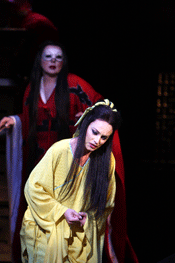 Sabina Cvilak (fore) as Liu, Maria Guleghina (back) as Turandot
Sabina Cvilak (fore) as Liu, Maria Guleghina (back) as Turandot
The opening night was the usual spectacle of tuxes and gowns. My husband
really liked the live Terracotta Warrior in the lobby; I thought it was,
perhaps, a tad over the top. There were inevitable first-night kinks; and no,
I am not talking about an unidentified heavy object crashing backstage
half-way through Turandot’s opening aria, which all those present have
been determined to forget. The kinks concerned the issues of balance and
timing, as the conductor Keri-Lynn Wilson tried to keep various sections of
the large orchestra, chorus, and soloists in a perfect synchronicity required
by Puccini’s famously complex score. The first act in particular
occasionally felt like a gigantic house of cards, shaking slightly, just on
the verge of collapse. Thankfully, it never quite did, and as the performance
progressed, the tremors mostly subsided, save for only an occasional
aftershock.
Argentine tenor Dario Volonté as Calaf hit every note; he demonstrated the fiery metallic timbre, and the alternatively aggressive and brooding personality essential for his character. Yet, his voice had no lyricism, no warmth, and most importantly, no sustaining power — at least not last night — that would have allowed the listener time to appreciate all those head-spinning highs before they sputtered and died like wet Chinese fireworks. His Act 3 pièce de resistance, “Nessun dorma”, was so rushed that the orchestra had trouble keeping up. There was no cantilena, no luxurious lingering on the final “Vincero!”, and consequently, Turandot’s most glorious moment and one of Puccini’s best-known tunes, probably for the first time in its history, evaporated without even a smattering of applause.
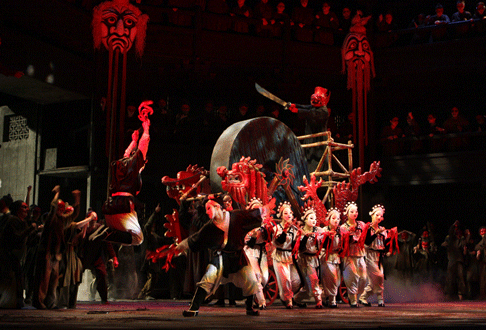 Scene from Act I
Scene from Act I
The first applause of the night belonged to Slovenian soprano Sabina Cvilak as Liù, and deservedly so. Her tiny, brittle figure, dwarfed by the scenery and the other characters, was an embodiment of Puccini’s fragile, tragic heroine, the most human character in Turandot (in a stroke of directorial inventiveness, Liù is never masked). And the vocal interpretation was spot-on: pure, crystalline highs; easy, unforced delivery; power to soar above the orchestra at will, but exercised sparingly, in preference to the heart-breaking pianissimo that somehow, miraculously, was perfectly audible (kudos here also to Ms Wilson for her sensitive conducting).
There could have been no greater contrast between Ms Cvilak’s Liù and Princess Turandot as presented by celebrated Russian dramatic soprano Maria Guleghina. Here, everything was the opposite: tall, imposing figure; stylized kabuki gestures; earth-shattering power of the voice that waited until the opera’s finale to drop below fortissimo and was meanwhile so intimidating, one barely noticed that it was almost impossible to discern the words that came out of Ms Guleghina’s mouth. Like the “citizens of Peking,” we simply submitted to the iron will of the Daughter of Heaven, and waited for precise instructions from her Mandarin.
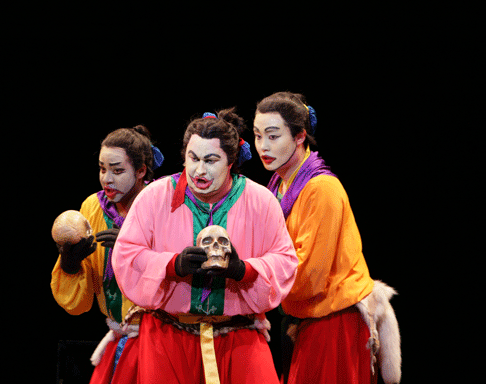 Norman Shankle, Nathan Herfindal, Yingxi Zhang as Ping, Pang and Pong
Norman Shankle, Nathan Herfindal, Yingxi Zhang as Ping, Pang and Pong
The Mandarin, Ukrainian Okeskandr Pushniak, was acceptable if not at all intimidating in his tiny part, and was much more interesting to look at than to hear, clad as he was in one of Sally Jacobs’ fabulously colorful creations. Much better — a highlight of the evening, in fact — were Ping, Pang, and Pong (Nathan Herfindahl, Norman Shankle, and Yingxi Zhang, respectively), who garnered accolades for their nice comic timing, and delivering strong vocal performances while endlessly moving, dancing, and literally doing cartwheels around the stage. Indeed, the choreography created by Kate Flatt for their parts and throughout Turandot proved to be one of the strongest elements of the production. Particularly interesting was the fluid continuity of stylized gestures and movements that all performers shared. Blurring the boundaries between the soloists, the chorus, and the dancers, the technique delivered a stunningly unified visual effect.
This unity was clearly the stage director’s goal, realized with the support of Jacobs’ designs, Flatt’s choreography, and F. Mitchell Dana’s lighting. For this alone, it is worth seeing Andrei Şerban’s magnificent interpretation of the Puccini classic — now, at 25, a classic in its own right.
Olga Haldey
image=http://www.operatoday.com/Dario-Volonte-as-Calaf%2C-Mar.gif image_description=Dario Volonte as Calaf, Maria Guleghina as Turandot [Photo by Karin Cooper courtesy of Washington National Opera] product=yes product_title=Giacomo Puccini: Turandot product_by=Princess Turandot: Maria Guleghina (May 16, 19, 21, 24m, 27), Sylvie Valayre (May 30, Jun 1, 4); Calaf: Darío Volonté (May 16, 19, 21, 24m), Franco Farina (May 27, 30, Jun 1, 4); Liù: Sabina Cvilak (May 16, 19, 21, 24m), Maija Kovalevska (May 27, 30, Jun 1, 4); Timur: Morris Robinson; Ping: Nathan Herfindahl; Pang: Norman Shankle; Pong: Yingxi Zhang; The Mandarin: Oleksandr Pushniak; Emperor Altoum: Robert Baker; Prince of Persia: Seong Won Nam. Conductor: Keri-Lynn Wilson (May 16, 19, 21, 24, 27, 30, Jun 1). Plácido Domingo (Jun 4). Director: Andrei Şerban. product_id=Above: Dario Volonte as Calaf, Maria Guleghina as TurandotAll photos by Karin Cooper courtesy of Washington National Opera
Athalia — Lincoln Center Great Performers Series
Many of them can be staged, and are; I have seen stagings of Susanna, Samson and Belshazzar, among the “sacred” oratorios — not to mention the famous video of Peter Sellars’ Theodora and stagings of the “secular” oratorios, Semele and Hercules. Several of the sacred oratorios — notably Esther and Athalia, from Racine, and Hercules, from Sophocles — are based to varying degrees on actual stage plays. Too, Handel had written some two dozen operas before he turned to oratorio, propelled as much by poor management decisions in managing his Italian singers as by the English demand for musical entertainment in English — much as he missed the scenery and special effects, he saw no reason not to exploit his gifts for characterization and high drama, and much to add in the use of a chorus, which became affordable when he gave up scenery, costumes and ballet.
Athalia, his third sacred oratorio and the one, critics agree, where he broke stride into greatness, is the melodramatic tale of one of the Old Testament’s most unusual figures, the queen who usurped the throne of Judea, massacred the royal family (including her own children and grandchildren), and restored the worship of Baal to Jerusalem. After seven years, she was overthrown and slain by the one grandson who escaped the massacre. Although her reputation has been obscured by that of her mother, Jezebel, it’s a heck of a story, and Racine (modeling his tale on Greek tragedy) summed it up in one extraordinary day, as does Handel. (Sukkoth, apparently — the celebrations in the Temple are of a harvest festival.)
As presented at the newly refurbished Alice Tully Hall by the Concerto Köln, Athalia was almost restive in its concert chains, straining to get out and be a drama at every twist and turn. All the fine singers were acting, and Concerto Köln made the most of Handel’s various accompaniments: the slashing strings (one section after another), for example, as the renegade priest Mathan reflected on what was in store for him now that God had defeated Baal, or the recorders that attempted to console the restless, guilt-ridden Athalia. Rhythms were crisp and danceable, and the tension of the story never relaxed.
It takes some skill to chew scenery when there is no scenery, and Simone Kermes, as Athalia, had it down — you wouldn’t want to get in her way. She was in character the moment she walked in: hair dyed red to match her flouncy orange and yellow gown and gold platform pumps, eyes starting from her head, every movement expressing a woman of emotional extremes. She underlined every extravagant syllable with voice and gesture (words like “gore” and “horror” got special attention), and her fruity, Germanic vibrato shook the hall. She looked and sounded not of the same world as the other singers — unlike her, mostly British — as was only proper for this alien, sympathetic-repulsive figure, tragic in her resolve to face the collapse of all her schemes.
The contrast this made with Sarah Fox as the confident (but not untroubled) Josabeth, Athalia’s daughter who has secretly preserved the last prince of the royal house, could hardly have been greater. Fox has a huge, bright, vibrato-free, clarion sound with perfect attention to every little turn and grace note, the perfect instrument for Josabeth’s passionate convictions — she could be a young Sutherland, except that her diction is outstanding. Josabeth is Handel’s voice of the idealist who will triumph — his librettist omitted the prophecies of Judaea’s decadence in Racine, which didn’t suit the mood in Oxford in 1733. Johannette Zomer was charming in the small trouser (well, knicker) role of Prince Joas, given to a boy in Handel’s day.
The men were not quite so exciting, so involved, as the women. James Gilchrist sang a thoughtful Mathan, humanizing the turncoat’s obsequiousness and despair just as Handel does. Iestyn Davies sang the role of the high priest, Joad, with confidence and lovely floating head tones, very much in the rather undemonstrative English countertenor tradition. Neal Davies sang Abner, one of Handel’s bass generals, such a joy, amid trumpets and drums, in the right throat — but though he hit all the notes, I found the notes themselves hollow, ill-supported, unresonant. His was the only second rate performance of the occasion, and he the only performer I would not be eager to hear again.
Two dozen is the maximum number I ever care to hear in a Handel chorus, no matter the size of the hall. The Balthasar Neumann Choir number twenty-five, but I forgive them, on account of the precision of their music-making and the subtle phrasing they impart to choruses of triumph, of prayer, of seductive luxury (when priests of Baal), of nuance to words like “groan” and “wound” — when Handel gets a word like that, he makes the music feel it, and the Neumann Choir made us feel it too.
John Yohalem
image=http://www.operatoday.com/Athaliah.gif image_description=Athaliah, as depicted in Antoine Dufour’s Vie des femmes célèbres, c. 1505; in the Dobrée Museum, Nantes, France. product=yes product_title=G. F. Handel: Athalia product_by=Athalia: Simone Kermes; Josabeth: Sarah Fox; Joas: Johannette Zomer; Joad: Iestyn Davies; Mathan: James Gilchrist; Abner: Neal Davies. Balthasar Neumann Choir, Concerto Köln, conducted by Ivor Bolton. Lincoln Center Great Performers Series, Alice Tully Hall, May 16.TCHAIKOVSKY: The Maid of Orléans — Moscow 1971
Music composed by Pyotr Il’yich Tchaikovsky to his own libretto after Friedrich von Schiller’s Die Jungfrau von Orleans (1801), tragedy translated by Vasily Andreyevich Zhukovsky, Jules Barbier’s Jeanne d’Arc and Auguste Mermet’s libretto for his own opera, after Barbier (1876), with various details adapted from Henri Wallon’s biography of Joan of Arc.
First Performance: 13/25 February 1881, Mariinsky Theatre, St Petersburg
| Principal Roles: | |
| Joan of Arc | Soprano/Mezzo-Soprano |
| King Charles VII | Tenor |
| Agnès Sorel | Soprano |
| Dunois, French knight | Baritone |
| Lionel, Burgundian knight | Baritone |
| Archbishop (Cardinal in first production) | Bass |
| Raymond, Joan’s betrothed | Tenor |
| Thibaut d’Arc, Joan’s father | Bass |
| Bertrand, a peasant | Bass |
| Lauret | Bass |
| A Soldier | Bass |
| Voice from the Angelic Choir | Soprano |
Setting: France, 1431
Synopsis:
Act I
A forest near Domrémy
Thibaut, father of Joan, wants her to marry Raymond. Joan refuses, declaring that she must follow her divine destiny. Enraged, her father accuses her to be in league with the devil. News arrives that the English are devastating nearby villages. Joan inspires all to hope because Salisbury, the English commander, is destined to perish. When a soldier brings news of the death of Salisbury; all sing hanks to the Lord. Joan bids farewell to save France.
Act II
At the Castle of Chinon
The minstrels sing and gypsies dance to amuse King Charles VII and his mistress Agnès Sorel. The vassal Dunois informs the King that the royal treasure is exhausted. He urges the King to take arms. To the disdain of Dunois, Agnès offers him to contribute her own money to finance the war. The archbishop receives a report of a miracle — the French have won thanks to troops led by a young girl. Joan presents herself to the King, telling him her story. The King gives her command of the army.
Act III
Near Reims
Giovanna engages in a duel with Lionel, a Burgundian allied with the English. But when she is about to strike the deadly blow, Joan sees his face, evoking tender pity. They immediately fall in love. Lionel swears allegiance to the French cause. At the cathedral of Reims a great crowd forms to celebrate Charles’ coronation. Thibaut publicly accuses Joan of witchcraft. Dunois defends her and the archbishop questions her. Feeling guilty of her love for Lionel, Joan remains silent. Lionel implores her to run away; but she accuses him that his love has caused her downfall.
Act IV
In the forest
Lionel and Joan embrace. A choir of angels sings a warning to the girl: she has betrayed her divine mission She must therefore suffer before she receives salvation. An English contingent arrives, killing Lionel and capturing Joan.
At the old market of Rouen
The English condemn Joan to the stake for being a witch. Joan asks Dunois for a cross, which he gives her. As the fire consumes her, the celestial voices promise her a place next to God.
Click here for the complete libretto (Russian).
Click here for the complete text of Die Jungfrau von Orleans.
Click here for the complete score.
image=http://www.operatoday.com/joangauguin.gif image_description=Joan of Arc by Paul Gauguin audio=yes first_audio_name=Pyotr Il’yich Tchaikovsky:The Maid of Orléans: [Orleanskaya deva] first_audio_link=http://www.operatoday.com/Maid1.m3u product=yes product_title=Pyotr Il’yich Tchaikovsky:The Maid of Orléans: [Orleanskaya deva] product_by=Irina Arkhipova: Joan; Vladimir Makhov: King Charles; Klavdiya Radchenko: Agnès Sorel; Vladimir Valaitis: Dunois: Sergey Yavkovchenko: Lionel; Lev Vernigora: Archbishop; Andrey Sokolov: Raymond; Viktor Selivanov: Bertrand; Vartan Makelian: Soldier; Yevgeny Vladimirov: Thibaut. Moscow Radio Chorus and Symphony Orchestra. Gennady Rozhdestvensky, conducting. Moscow, 1971.May 14, 2009
Weber’s Der Freischütz at Zurich Opera House
Its combination of lush early Romanticism and German folk tale, both grim and gay, doesn’t seem to register outside of its native country. The score mostly lives on in frequent playings by classical radio stations of the magnificent overture. But there is much, much more great music in this score, and any production that manages to draw an audience into the eerie world of the opera deserves respect.
This 1999 staging by Ruth Berghaus has appeared on DVD before, and Arthaus Musik is to be thanked for this re-release. A traditional staging might work, but it would have to be done with remarkable taste. The vaguely Faust-like story centers on a failure of a hunter, Max, who wants to win the hand of Agathe. Kaspar owes his soul to a devil figure, Samiel, but Kaspar hopes to manage his escape by tricking Max into taking his place. To ensnare Max, Kaspar produces magic bullets that can help Max earn Agathe’s respect as a hunter. At the climax, Kaspar thinks he has manipulated Max into shooting Agathe, but instead, he ends up taking the last magic bullet himself.
Berghaus employs some of the familiar tropes of regie-theater, including men in overcoats and fedoras and a stark set of golden-hued floor and walls. The set shifts into various conformations, with a pit appearing at one point, as well as shifting ramps and an opening high up on one wall for Agathe to appear in before the final shot. The audience takes awhile to settle into Barghaus’s vision, and when Max’s first shot with a magic bullet produces a veritable avalanche of black feathers, chuckles are heard. Soon the off-kilter set and stylized movement cohere into a vision of a foreign yet familiar world, one that suits both the folk nature of the tale and the supernatural elements.
An excellent cast gives itself over to Berghaus’s vision. Matti Salminen dominates as Kaspar, his weighty yet never ponderous bass managing to be both avuncular and ominous as necessary. The leads in a tale such as this tend to be anonymous creatures, but both both Peter Seiffert as Max and Inga Nielsen as Agathe find interesting angles, under the direction of Berghaus. Seiffert’s anxious Max appears as an outsider to the mainstream of village life from the start, an early version of the “misunderstood bad boy” James Dean supposedly invented. Although the libretto doesn’t provide much interaction between the two romantic leads — they don’t even appear together until the middle of act two — Nielsen and Seiffert both suggest the torment of their thwarted romance. Although she is done no favors by the close-ups, Nielsen sings youthfully, except for a tendency for extended high notes to lose tone. Malin Hartelius, as Agathe’s friend Ännchen, however, steals her scenes with the heroine, employing a rich, warm mezzo.
The appearance of the Mephistopheles character, Samiel, produces a suitable chill, and the entire Wolf’s Crag scene manages to be, if not exactly scary, disturbingly weird. Berghuas still respects the intimate moments of the opera, such as Agathe’s second act aria, by letting the focus remain on the singer and not introducing distracting stage business.
The excellent sound captures some audience noise, but nothing too detrimental. Nikolaus Harnoncourt has a reputation for idiosyncratic tempos, but his reading here is well-paced and colorful.
To all but those utterly resistant to non-traditional stagings, this Der Freischütz can be considered a DVD classic. Pick it up if you missed it on its first go-round.
Chris Mullins
image=http://www.operatoday.com/Arthaus107011.gif imagedescription=Carl Maria von Weber: Der Freischütz
product=yes producttitle=Carl Maria von Weber: Der Freischütz productby=Ottokar: Chenye Davidson; Kuno: Werner Gröschel; Agathe: Inga Nielsen; Ännchen: Malin Hartelius; Kaspar: Matti Salminen; Max: Peter Seiffert; A Hermit: László Polgár; Kilian: Volker Vogel; Samiel: Raphael Clamer. Zurich Opera House Chorus. Zurich Opera House Orchestra. NIkolaus Harnoncourt, conductor. Ruth Berghaus, director. Hartmut Meyer, set design. Marie-Louise Strandt, costumes. productid=Arthaus Musik 107011 [2DVDs] price=$34.49 producturl=http://www.arkivmusic.com/classical/Drilldown?nameid1=12850&namerole1=1&compid=4780&genre=33&labelid=4357&bcorder=1956&nameid=14322&namerole=3
L’elisir d’amore at Covent Garden
Laurent Pelly’s 2006 staging, first seen at Covent Garden in 2007 and revived here by Daniel Dooner, certainly supplies much absurdity, capriciousness and inanity, but it is rather lacking in genuine warmth and tenderness. In this ‘busy’ staging, characters are entertaining but not fully engaging; we smile gently at their follies and witticisms, but they don’t truly touch our hearts. We don’t really care; and, it seems, neither do they. The humour is largely visual: indeed, on the opening night the largest laughs were raised by the manic terrier which intermittently whips across the stage, and by the between-scenes front cloth advertising Doctor Dulcamara’s entire range of miraculous potions and lotions - the clutter of cures for Constipazione and Impotenze recalling an email inbox, deluged by SPAM offering fake Viagra.
Striving for a realism that would put many a verismo production to shame, Pelly furnishes his stage with a relentless assemblage of period props — tractors, lorries and Vespas — to evoke rural, post-war Italy. The curtain rises on a precipitous mound of hay-bales. It’s true that this Nemorino — a foolish bumpkin — certainly has a mountain to climb if he’s to win the hand of Diana Damrau’s feisty, spoiled Adina. While the workers toil in the sun-drenched fields, the queen bee perches aloft, preening herself beneath her pink parasol, laughing disdainfully at tales of ‘real’, un-dying love of the kind that will later catch her unawares.
No-one could accuse Giuseppe Filianoti of lack of commitment: as Nemorino he, literally, throws himself into the part, hurling himself around the stage like a hyperactive child, tumbling and flailing in a hopeless effort to catch the eye of the indifferent Adina. When Dulcamara declares that he met a few fools in his time but none quite as dim as Nemorino we are inclined to nod in agreement. While this self-deprecating slapstick raised a few chuckles, it did not distract from Filianoti’s vocal weaknesses. His is a dark-toned tenor, but the upper range is strained and reedy, and his opening number was particularly uncomfortable. In the Act 1 finale he seemed completely adrift, musically and dramatically. Despite these problems, there were moments to admire. Filianoti’s diction is excellent, he uses the words well, and his performance did improve as he slowly warmed up. He certainly conveyed Nemorino’s ardency and sincerity in the Act 2 ‘Una furtiva lagrima’. Yet, it was rather an effort, and the simple elegance required to communicate the profound, ‘poetic’ sensibility to be found beneath the buffoon’s clownish exterior was lacking.
As Adina, the German soprano, Diana Damrau, commands the stage. Dressed in a seductively low-cut dress (costumes are by Chantal Thomas), she flirts and flaunts, incessantly prancing, posing and pouting. However, while she entirely lacks innocence and does not really earn our sympathy, she can be forgiven for these exaggerated excesses as she renders Donizetti’s lyrical melodies and capricious coloratura with delicious beauty and ease. Outraged by the attention that Nemorino’s new-found wealth garners from the other girls, Damrau’s fiery fioratura is flawless. And, her declaration of love - a stunning two-octave plunge sealing her promise to make him ‘as happy as I used to make you miserable’ - is the high-point of the evening.
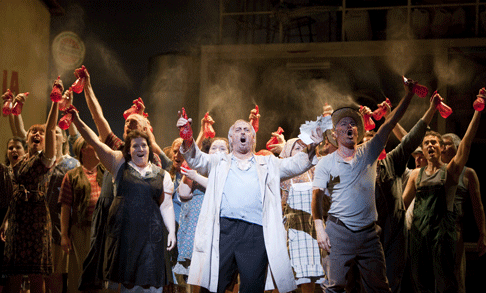 Simone Alaimo as Dulcamara and The Royal Opera Chorus [Photo by Johan Persson courtesy of The Royal Opera House]
Simone Alaimo as Dulcamara and The Royal Opera Chorus [Photo by Johan Persson courtesy of The Royal Opera House]
The Sicilian bass-baritone, Simone Alaimo, played Dulcamara as if this was his five-thousandth performance of the role … perhaps it was. His buffo gestures were rather tired; even the chorus, who excitedly anticipated his entrance, didn’t wait around to hear his sales pitch — leaving Alaimo addressing an empty stage. A sharp, red suit in Act 2 enlivened him somewhat; responding to Adina’s confident assertions that the power of her own physical attributes is more than a match for any elixir Dulcamara cares to offer, he demonstrated more energy and sparkle. But, Pelly seems to view the quack doctor less as a loveable rogue than as a greasy slime-ball. Like Anthony Michaels-Moore’s cock-sure Sergeant Belcore, he is presented as a cynical opportunist. In Belcore’s opening aria, despite standing aloft the hay-bales, a ‘king of the mountain’, Michaels-Moore struggled to project his baritone; he was a rather one-dimensional figure throughout, a charmless bully. The Japanese soprano, Eri Nakamura, supplied the evening’s one genuine moment of sweet, unaffected tenderness, as Giannetta.
Pelly’s direction of the chorus is confusing and over-emphatic. At times, they are uncompromisingly involved in the action, was in the opening scene when they taunt and torment Nemorino with an alarming aggression! Elsewhere they ignore the action entirely, and face forwards, immobile, to address the audience — a gesture which lacks subtlety, relevance and becomes increasingly irritating.
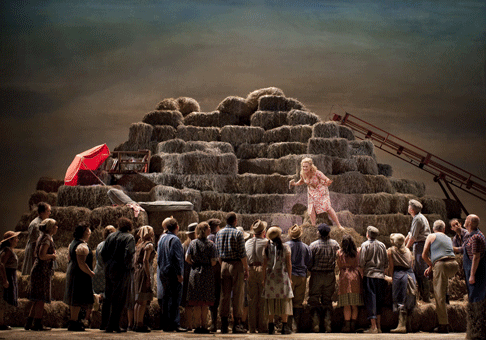 A scene from L’elisir d’amore [Photo by Johan Persson courtesy of The Royal Opera House]
A scene from L’elisir d’amore [Photo by Johan Persson courtesy of The Royal Opera House]
Despite Pelly’s desire for realism, this production does not truly convey the dark side of the drama - the potential sadness, even tragedy, hiding behind the comic frills, or the cynical exposure of the true elixir of love: money. Fortunately, Bruno Campanella understands the aesthetics of bel canto, and he stylishly controlled the colour and pace of the performance from the pit.
So, in this visually catchy production there is lots to entertain and much to admire, but perhaps rather less to enchant.
Claire Seymour
image=http://www.operatoday.com/ELISIR-2009_00883-DAMRAU-AS.gif image_description=Diana Damrau as Adina and Giuseppe Filianoti as Nemorino [Photo by Johan Persson courtesy of The Royal Opera House] product=yes product_title=Gaetano Donizetti: L’elisir d’amore product_by=Adina: Diana Damrau; Nemorino: Giuseppe Filianoti; Dulcamara: Simone Alaimo; Belcore: Anthony Michaels-Moore; Giannetta: Eri Nakamura. The Royal Opera. Conductor: Bruno Campanella. Director: Laurent Pelly. Costume Designs: Laurent Pelly. Set Designs: Chantal Thomas. Lighting: Joël Adam. product_id=Above: Diana Damrau as Adina and Giuseppe Filianoti as Nemorino [Photo by Johan Persson courtesy of The Royal Opera House]Gustav Mahler: Symphony no. 3
Like the DVD of Mahler’s Second Symphony, which was already released, this one of the Third conveys the energy of the live performance. From the start, various details become evident, as with the presence onstage from the start of the soloist Anna Larsson and also the choruses in the balcony above the stage. Likewise, the cameras catch in the opening minutes of the first movement the prominently raised bells of the French horns, as indicated in the score with the marking “Schalltrichter auf” (“bells up”). Beyond the adherence to such markings, the playing is energetic from the start, with vigorous bowing in the strings, to create the full and incisive sound characteristic of this performance. At the same time, the quieter effects are clearly present, and it is useful to have the camera focus, for example, on the timpani passage, which is to be played softly. The softer sound is no mistake, and the film confirms the sound with the visual image. Elsewhere, it is possible to see the ways in which Abbado achieves his fine result, as with the cloth coverin the bells of the trumpets and trombones certain passages of the Finale, a variation on the way in which some conductors sometimes have the brass play into the music stands.
Yet it is details like these that set apart Abbado’s performance in this recording from other performances of this Symphony. His sense of the form of the expansive first movement brings the various thematic ideas together convincingly. At the point in the score just before the reprise that signals the concluding section, Abbado achieves a the notated dynamic level without sacrificing precision or control. Rather, the softer volume allows the ensemble to articulate the musical ideas with welcome precision as Abbado brings the movement to an exciting and resonant conclusion.
Similar details emerge in the second movement, which follows relatively quickly after the first movement. While Mahler marked the score to have a break of at least five minutes between those two movements, absolute precision with the timing is not necessary, as evident here. It is useful for the orchestra to regroup, as it were, before proceeding with the second movement and thus to convey to shift of mood in this orchestral idyll. Some of the figuration evident here evokes connections with the accompaniment of the song “Das himmlische Leben,” which Mahler used as the Finale of the Fourth Symphony and was, at one time, considered for inclusion in the third. Elsewhere the string writing suggests the reflective tone Mahler had achieved in the second movement of the Second Symphony. Here, though, the ensemble brings about the precision which allows the shifting colors of the movement to be heard cleanly.
At the center of the Third Symphony are three movements which have vocal connections: the third movement is a Scherzo in which Mahler makes use of his Wunderhorn setting “Ablősung im Sommer”; the setting for alto of a text from Nietsche’s Also sprach Zarathustra; and the Wunderhorn poem “Es sungen drei Engel” for alto and chorus. Abbado makes the lyrical element apparent without belaboring, and this is nicely balanced in the third movement. In that piece the closeups of the woodwinds reveal the engagement of the players as they work together in tight ensemble. The result is a distinctive execution of the accompaniment which allows the cantabile line to emerge with ease. In fact, the intensity Abbado has given to the third movement is remarkable for the way it brings out thematic ideas that are often found in analysis, but not often made so audible. In bringing out the vocal elements, Abbado allows the motives in the accompaniment to be heard distinctly. At the same time some of the figures anticipate ideas that Mahler will pursue in the subsequent movements of this work, as with the motives in the timpani, which will be heard in augmentation in the Finale. Throughout this movement, the Abbado carefully follows the dynamics, so that the climax is precisely where the composer wanted it, and this leads directly to the conclusion of this remarkable Scherzo.
With the fourth movement, Anna Larsons is heard for the first time in this work, and her interpretation of Nietzsche’s “O Mensch, gib acht” is impressive for the singer’s engagement with the text. The accompaniment may seem louder than sometimes occurs in the concert hall, and this might be the result of the recording techniques. Even so, the balance between the vocal part and the instrumental accompaniment is effective, with the closing measures of the movement appropriately reserved. The relatively quiet ending stands in contrast to the ringin opening of the choral movement which follows. Here, again, the sound is relatively close and perhaps louder than one usually hears in a live performance. Nevertheless the solid recording techniques allow the choral sound to blend nicely with the orchestra beneath it. While the solo part for Larsons is relatively short, it shows the mezzo soprano in fine style as she sings the part of the repentant Saint Peter in this Wunderhorn setting.
In bringing the work to its conclusion, Abbado contributes a well-thought pacing to the slow movement with which the Third Symphony ends. While never belaboring the slow tempos, Abbado is also keen to allow for some flexibility, as with the motive in the horns near the beginning of the movement, which requires the agitato approach he has given it. The pauses which Abbado brings to the movement are entirely appropriate to the musical structure and also the resonant sonorities he achieves in the performance. This and other nuances in tempo are essential the movement, and Abbado is particularly effective in this regard. Within the larger structure of the slow movement, the individual sections that comprise have shape and, as individual units, contribute to the whole. At the core of the movement is the warm, rich string sound, which is quite apparent in this recording. The intensity of the playing, along with Abbado’s fine direction results in an outstanding performance of this movement.
This film of the Third Symphony shows the hall in a brighter light than evident on some other videos from Abbado’s Lucerne cycle, and this allows for some fine shots of the orchestra, along with Abbado himself. The conductor’s presence can be visually more convincing with the audience around him, rather than as a silhouette with an almost black background. At some points the lighting makes it possible to read the music on the instrumentalists’ stands, an element that contributes to the overall sense of the live performance. It is, however, unfortunate, that the blue exit signs in the hallways are sometimes prominent. This is a minor point, but in a video this compelling, such a detail emerges along with the other, positive ones.
The accompanying booklet is lists the movements, timings, principals, and some production details, without the extensive notes that sometimes occur. Werner Pfister’s short essay “Selige Zuversicht” (“Blissful Trust,” as translated here), is useful in giving some perspectives on the aims of the Lucerne Festival and Abbado’s aims with this specific performance. Pfister’s comment that “Abbado’s Mahler is precisely calculated and at the same time intuitively felt” bears explication, though. Some of the connotations of “kalkuliert” in English suggest the pejorative, and it is clear that the precision Abbado achieves serves his purpose in bringing to his audience a thorough and reliable reading of the score. No matter what the program notes state about it, listeners have the opportunity to hear for themselves how well Abbado performs Mahler’s Third Symphony.
Several DVD performances of Mahler’s Third Symphony exist, but this one by Abbado stands out as particularly effective for its impeccable interpretation and execution. A challenging work because of its length and the range of music within it, the Third sometimes reaches audiences with some elements wanting, and that is not the case in this recent release. One of the foremost conductors of his generation, Abbado demonstrates yet again his masterful approach to Mahler’s demanding scores in this festival peformance of the Third Symphony. The rhythmic applause and extended ovation at the end are certainly an appropriate response to the efforts of Abbado and the Lucerne Festival Orchestra.
James L. Zychowicz
image=http://www.operatoday.com/Medici2056338.gif imagedescription=Gustav Mahler: Symphony no. 3
product=yes producttitle=Gustav Mahler: Symphony no. 3 productby=Anna Larsson, mezzo soprano, Tőlz Boys Choir, Women of the Arnold Schoenberg Choir, Lucerne Festival Orchestra, Claudio Abbado, conductor. productid=Medici Arts 2056338 [DVD] price=$21.49 producturl=http://www.arkivmusic.com/classical/Drilldown?nameid1=7537&namerole1=1&compid=1799&genre=66&bcorder=195&labelid=5709
May 13, 2009
Peter Grimes — English National Opera, London Coliseum
In one of the production’s creepiest moments, the big man-hunt chorus in the middle of Act 3 is accompanied by waving of miniature Union Jacks.
Everyone you focus on has a darker secret than the last. At the more normal end of the range are Felicity Palmer’s Miss Marple-esque Mrs Sedley and Leigh Melrose’s apparently speed-addicted Ned Keene. The most disturbing include Darren Jeffery’s Hobson, who appears to have a whole boy-killing factory of his own going on unnoticed right under everybody else’s noses. Weirdest of all are Auntie and the Nieces — Rebecca de Pont Davies as a club-footed cross-dresser with a pinstripe suit and walking cane, and Mairéad Buicke and Gillian Ramm as a pair of possessed zombie twins in identical school uniform and pigtails. The Nieces are the production’s only faintly jarring note, with their vacant and jerky choreography which makes them barely even recognisable as human beings, but if they have one dramatic function it’s giving a new layer of depravity to Bob Boles, Swallow and everybody else who shows a sexual interest in them. Perhaps they are the ultimate product of this diseased community.
Yes, it’s the norm here to be disturbed, deformed or damaged (even Balstrode, sung by the excellent Gerald Finley, is missing an arm — besides the costumes, this is the most obvious visual clue to the production’s 1940s setting, though Auntie seems a throwback to the 30s) and Peter and Ellen are seemingly the only complete and sane individuals among them. Although her even-temperedness and common sense make her stand out from her neighbours, Ellen is integrated into the community — a community where people do everything together, moving in swarms — but Grimes is a loner, and it is this and this alone which leads to his becoming the local scapegoat. By the end, they have poisoned him into madness, but at least he is able to escape through death. Ellen is the one who has to live with it all, and I dare say she fits right in with the rest of them after all she has been through. With Amanda Roocroft in the role, there are echoes of her recent, brilliant Jenufa here — a bright-natured, attractive young woman worn down through her experiences. At times her singing is shrill on top and her diction indifferent, but her character portrait is spot on, the relationship with Grimes filled with real tenderness.
The Australian tenor Stuart Skelton is as fine a Grimes as you could wish to hear, wielding both his large voice and burly physique with intelligence and subtlety. Emerging from the man-hunt and the subsequent pained calm of the final interlude, Alden’s staging of the mad scene is devastating in its simplicity: the surtitle screen and orchestra pit go dark, and Grimes is alone in the abyss beneath a grey and foggy sky. Skelton maximises the effect the solitude of the setting with a performance of heartbreaking vulnerability and emotional intensity.
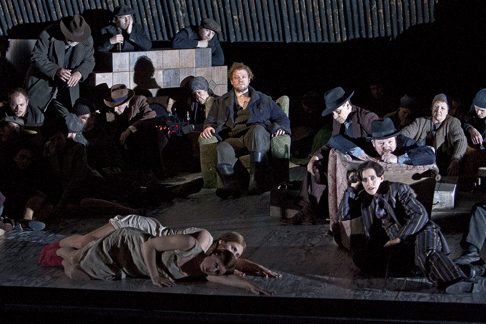 Peter Grimes (Stuart Skelton); Auntie (Rebecca de Pont Davies) (front rt); Bob Boles (Michael Colvin) (front rt in upturned chair); First Niece (Gillian Ramm) (lying down front nearest); Second Niece (Mairéad Buicke) (behind first neice)
Peter Grimes (Stuart Skelton); Auntie (Rebecca de Pont Davies) (front rt); Bob Boles (Michael Colvin) (front rt in upturned chair); First Niece (Gillian Ramm) (lying down front nearest); Second Niece (Mairéad Buicke) (behind first neice)
As Grimes hears the drum-led procession approaching his hut — in a clear and chilling musical echo of his vision, moments earlier, of the first dead boy — he is distracted into letting go of the rope with which he is making safe John’s descent down the cliff. Thus the villagers become directly responsible both for the death of the apprentice and for Peter’s self-destruction as a result of it. It is a heart-stopping coup-de-theatre.
In the two years that Ed Gardner has been ENO’s Musical Director I don’t think he has ever drawn a better performance from the house orchestra than in this detailed but never fussy account of the score. The playing of the interludes was virtually faultless, with a particularly memorable brass timbre, the jazzy shape of the phrases in the Storm Interlude crafted so as to introduce the incongruous 1930s vintage of the inhabitants of the Boar. A number of remarkable and inventive Grimes stagings have been seen in London this decade, but musically, this is head and shoulders above the others. It is perhaps ENO’s finest musical achievement this decade.
Ruth Elleson © 2009
image=http://www.operatoday.com/peter_grimes002.gif image_description=Peter Grimes (Stuart Skelton) and Ellen Orford (Amanda Roocroft) [Photo by Clive Barda courtesy of English National Opera] product=yes product_title=Benjamin Britten: Peter Grimes product_by=Peter Grimes: Stuart Skelton; Ellen Orford: Amanda Roocroft; Captain Balstrode: Gerald Finley; Auntie: Rebecca de Pont Davies; Swallow: Matthew Best; Ned Keene: Leigh Melrose; Bob Boles: Michael Colvin; Mrs Sedley: Felicity Palmer; First Niece: Gillian Ramm; Second Niece: Mairéad Buicke; Hobson: Darren Jeffery; Reverend Horace Adams: Stuart Kale; John, Grimes's apprenctice: Benny Gur. Conductor : Edward Gardner. Director : David Alden. Designer : Paul Steinberg. Costume Designer : Brigitte Reiffenstuel. Lighting Designer : Adam Silverman. Choreographer : Maxine Braham. product_id=Above: Peter Grimes (Stuart Skelton) and Ellen Orford (Amanda Roocroft)All photos by Clive Barda courtesy of English National Opera
Paris: Mostly Verdi Good Indeed
But let’s start with the “good luck” portion of the evening, shall, we? Make that “very good luck,” for musically there was not only a great deal to admire, but specifically, Violeta Urmana served notice that she is now to be numbered among the great vocal interpreters of the cruelly difficult role of Mrs. Macbeth. Announced as indisposed, she nevertheless sang up a storm, displaying her usual rich, creamy tone; searing high notes; thundering chest tones; and a well-judged sleepwalking scene in which she admittedly took a sightly lower (but no less effective) option in the final rising arpeggiated phrase. This was splendid singing with “La luce langue” as gorgeously presented as you are ever going to hear it, a perfect marriage of artist and aria.
We were almost as fortunate with our Macbeth, for Dimitri Tiliakos’s warm and sympathetic baritone was enormously engaging in mezzo forte passages, of which there are thankfully many. When Mr. Tiliakos pushed the volume in upper stretches, however, his rapid vibrato caused the unfortunate effect of not always being on any one specific pitch, but rather in the general vicinity of the vocal line, a minor shortcoming that disappeared when the voice turned over into those forte pitches above, say, “f.” To be fair, our baritone’s technique was eerily similar to the renowned Leo Nucci, who also has a tendency to get riled up and bully the upper middle a bit, not a bad role model since Leo seems to have managed a “decent” career!
Dmitry Ulyanov’s commanding Banquo was richly voiced with rolling orotund delivery. The Parisians seemed to get more excited about Oleg Videman’s Macduff than did I, his stentorian presentation of the heartbreaking aria seeming more appropriate to an audition for the Forging Scene, albeit one with exceptionally pleasing steely tone.
The Malcolm of Alfredo Nigro was so nicely sung that I half wished he had been the one given a go at “A la paterno mano”. As Lady Macbeth’s Attendant, Letitia Singleton offered more vocal presence than usual, and Yuri Kissin was the wholly competent physician.
The best musical news of the night is that conductor Teodor Currentzis seems to have redeemed himself after last season’s disastrously slipshod Don Carlo (which I still consider one of the worst led performances I ever hope to hear). Perhaps less mature Verdi suits the young Maestro’s flash-bang, flailing, hair-flying, semaphoric gyrations, but whatever the reason, this was a highly individual, nuanced reading from an orchestra and chorus in top form (Allessandro Di Stefano was the effective chorus master).
To be sure, there were some Sinopoli-esque curiosities with occasional tempi slower or faster than are traditional. The great chorus “Patria oppressa” seemed comprised of attractive bits and pieces, instead of an unbroken arc. And the final scene became too deliberate, when a steadier tumble to the denouement was to be desired. But it cannot be denied that Teodor’s take on Macbeth was controlled, vibrant, and fiercely theatrical, a feat that was rewarded with a tumultuous ovation at final call.
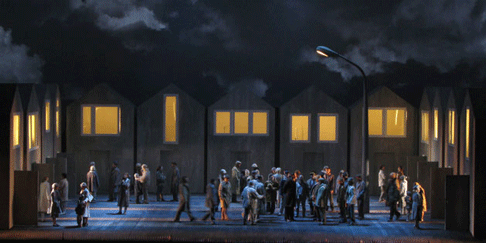 Scene from Macbeth [Photo courtesy of Paris Opéra]
Scene from Macbeth [Photo courtesy of Paris Opéra]
In light of the rich musical splendors, it seems a pity to have to report at all on the turgid and uninspired physical production. No doubt where the blame lies, for Dmitri Tcherniakov was in charge of stage direction, sets, and costumes. True, Gleb Filshtinsky did the competent lighting but at crucial moments, Tcherniakov managed to keep the characters’ faces out of it anyway.
The act curtain consisted of a swirling computer driven video projection of an aerial view of small modern town. The cursor at times scrolled over and selected a house or square for closer view and the video took us on a bird’s eye trip to the new locale. It was sort of a mix of that annoying projected scenery from Webber’s Woman in White and an Architectural Digest HBO Special.
The opening scene featured not witches nor a mysterious locale (Plot? What plot?) but an open courtyard lined with houses that inexplicably looked like seaside homes. The entire chorus, presumably residents of this square, simply milled about haphazardly, and there was no dramatic focus at all to the important predictions (we don’ need no stinkin’ plot).
The Macbeth’s live in a 19th Century mansion, and the sitting room (with working fireplace, Morris chair, and later, dining table) had sets of front drapes (one scrim, the other damask) that got pulled open and closed by our principals at various unmotivated junctures, rendering the room a stage within a stage. The fact that the picture frame around this playing space cut the actors off mid-calf was a constant, and avoidable visual annoyance.
And that sums up the entire set concept. We kept coming back to the quad for the outdoor scenes, and to the mansion for all the indoor scenes. Oh, except that the final battlefield scene was actually in the sitting room with Macbeth standing atop the table holding a hard copy of the city map in front of him. As he began “Pieta, rispetto, amore” he cast the map aside to reveal that, save his black DKNY boxer briefs, he was naked from the waist down. Thus he sat and lounged and stretched out and finally assumed a fetal position on the table, writhing in what remained of his formal wear.
The chorus burst in, and Macbeth ran off through the door, to be drug back on in a bloodied shirt for the not-oft-used death scene (very affectingly sung). But as he died, everyone left, and the great final chorus (including the Malcolm-Macduff solos) was sung offstage, slightly amplified, while salvos crashed through the Styrofoam walls destroying the house in a noisy assault that mercifully subsided for the final soaring choral statement.
Such directorial misjudgments were many and depressingly frequent. Lady M’s somnambulism was not allowed to be the usual solo act, oh no. Here she had to interact with the doctor and her servant, fighting, threatening, struggling, and even strangling her servant all the while; and at scene’s end, the focus was directed to the Lady in Waiting who was given the final word by sobbing hysterically. Can I tell you something Dmitri, just between us directors? This aria is not about the doctor nor the servant!! Not at all!! Not a bit!!!! It is about a great diva moving us with a great scena!!!!! (Whew. . .I feel better now).
The list could go on. Macduff came in to announce Duncan’s murder with his hand held to his forehead throughout in a way that suggested he was trying to stem a nosebleed. Then our poor tenor later had to sing his lament seated in a toy-cluttered child’s playpen. As if singing the “Brindisi” is not challenge enough, The Divine Lady M was asked to perform party magic tricks all during the aria, knotting silks and pulling them out of a top hat that she was made to carry with her later as a sleep walker. All of the apparitions simply failed to “appear” on stage at all(!), including Banquo’s ghost, asking way too much of Macbeth as an actor, and indeed way too much of the audience to know what the hell was going on.
The worst offense by Tcherniakov The Designer was arguably the pedestrian contemporary costuming, which reached criminal proportions (word carefully chosen) in the unflattering attire for Ms. Urmana, who sadly looked more like the leading man’s Wal-Mart shopper mom than his political and sexual equal. Are the days gone forever when gifted costumers and make-up artists and wig makers could fabulously glamorize full-figured artists like Joan, Leontyne, Marilyn, Montserrat? A pretty woman, and a major star soprano, Violeta deserves far far better.
At the end of the day, though, the utter nonsense of the staging was triumphantly swept aside by the conviction of as well-judged a musical reading of Macbeth as is likely possible today. A heads up in case you are Russia-bound: this is a co-production with the Opera of Novosibirsk where Teodor Currentzis is in charge, but where the available musical assets may not be of the same high quality. Just didn’t want you to wander in unaware.
At next night’s marvelous Un ballo in maschera, conductor Renato Palumbo’s style could not have been more different. With economy of gesture and a complete, under-stated understanding of how the piece works, the Maestro led a sensitive and sensible account that provided ample support for the first rate soloists and chorus.
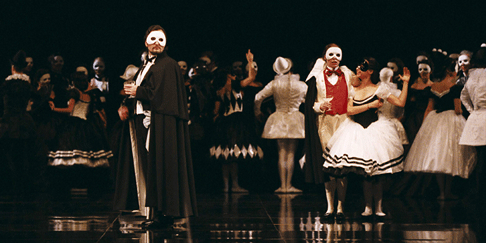 Scene from Un ballo in maschera [Photo courtesy of Paris Opéra]
Scene from Un ballo in maschera [Photo courtesy of Paris Opéra]
Visually, too, there was much to admire in William Orlandi’s handsome period costumes and monumental sets seemingly inspired by Mussolini’s architectural visions. At rise, Riccardo is discovered seated on a pretentious white marble throne, in the center of an amphitheater peopled by the male chorus, and surmounted by a huge marble eagle.
Such iconic images served the work very well indeed, with the gibbet consisting of two large square pillars, topped by menacing ravens, wings spread about to take flight; a mausoleum of a sitting room for Rentao and Amelia; and a perspective of a ballroom defined by a profusion of black marble pillars capped with large, softly lit, Lalique-look glass lamps. Ulrica’s lair seemed more uniquely “American” with its profusion of open flames and bayou voodoo-inspired milieu. Joël Hourbeigt’s evocative and atmospheric lighting could hardly have been bettered.
While the entire costume concept was also black and white, there were well-chosen flashes of color such as Ulrica’s rich red tunic and turban; and less well chosen, with Oscar plumped into a red vest that had the somewhat unfortunate effect of making our cross-dresser look a bit like a white suited Robin Red Breast. Especial praise should be reserved for the vibrantly detailed commedia dell’arte garb worn by the corps de ballets, although Micha van Hoecke’s busy choreography made their effect a little dizzying.
Stage director Gilbert Deflo knew how to tell the story, developed meaningful blocking and visually pleasing stage groupings, maintained excellent focus on the dramatic moments, and mostly appeared to stay out of the way of his exceptional cast. Only the duet scene might have benefited from more specificity of interaction, but that is a minor point in a very fine piece of direction.
This night’s indisposed singer was Ramon Vargas (the French announce this with some drama, with a great pause before . . .“but. . .Mr. Vargas has indeed accepted to perform the role for you”). Although Mr. Vargas chose his battles carefully in selecting which high notes to ring out and which to husband and nurse, my first reaction upon hearing him live is that this is a gorgeous heavy lyric sound. He is also a very fine musician, shaping and coloring his phrases with a fine sense of Verdian line and a good deal of dramatic imagination. His acting is honest and heartfelt. Perhaps his rather short, boyish, round-cheeked appearance does not make him as marketable as other over-hyped tenors, but as an artist this guy easily outclasses many an operatic poster boy. A class act this Senor Vargas.
My other real interest was in hearing Angela Brown, who has emerged in recent seasons as a Verdian of note. Her Amelia did not disappoint. The lovely Miss Brown commands the stage with star presence, and her ripe, dark tone communicates well in all registers and at all volumes, but most especially in the upper reaches at full throttle when she is downright thrilling. If her generous vibrato gets a bit in the way in lower parlando passages, and if she cannot quite float a high note as pristine as say, Mme. Caballe (who can?), this is nevertheless a very sound technique married to well-schooled musical instincts. On a non-musical note, the diva did milk her (solid) ovation a bit too much past the sell-by date. Leave them wanting more, Angela!
Anna Christy contributed a perky, spot-on, clear-voiced Oscar, although I wish she had strutted and play-acted the “boy” a little less. Elena Manistina was a force to be reckoned with as a fine Ulrica with a searing baritonal chest voice that blossomed quite seamlessly into a ripe middle and a secure top. The duo of dark-voiced Etienne Dupuis and Michail Schelomianski were luxury casting as an exceptionally powerful Silvano and Sam, and Scott Wilde presented a decent Tom.
But without a shred of doubt, the night (and the weekend) belonged to the tremendous performance by Ludovic Tezier as Renato. Once every five years you might encounter a Verdi turn with this shock-and-awe factor, and Mr. Tezier thrilled and chilled us the entire night. Having enjoyed his Figaro Count, and even more his Werther Albert, nothing prepared me for the richness, the moxie, the clarity, the size of that great instrument with its manly buzzy tone pinging off the back wall of the Bastille and pinning us in our seats. There is nothing quite like “discovering” a new star Verdi baritone, and wow, what a night he had! Us, too.
James Sohre
image=http://www.operatoday.com/Verdi_standing.gif image_description=Giuseppe Verdi product=yes product_title=Giuseppe Verdi: Macbeth product_by=Macbeth: Dimitris Tiliakos; Banco Ferruccio Furlanetto / Dmitri Ulianov (5, 8 May); Lady Macbeth: Violeta Urmana / Larissa Gogolevskaya (29 April and 5 May); Dama di Lady Macbeth: Letitia Singleton; Macduff: Stefano Secco / Oleg Wideman (5, 8 May); Malcolm: Alfredo Nigro; Medico Yuri Kissin. Opéra national de Paris Orchestra and Chorus. Conductor: Teodor Currentzis / Piotr Belyakin (17 April). Stage director, sets and costumes: Dmitri Tcherniakov.May 12, 2009
Der Ring des Nibelungen at the MET
It’s the sort of work for which the phrase “tour de force” was coined. First, you need a grandiose production using all the forces at your command (because we’ll all know just what you don’t command if you don’t have it here), and the Met had that — the much-loved Schenk-Schneider-Siemssen production, now being retired. (Will they destroy it? Or stash it and bring it back after a new one flops? Depends who’d have to pay the storage costs.) Second, you need a conductor and an orchestra, and James Levine, who has led so many Rings with the Met orchestra he so lovingly put together, is a known Wagnerian quantity. But even his experience cannot account for the lightness of touch, the ease with which the whole ponderous juggernaut glided, took flight, zipped seamlessly by, on the present occasion. Even the horns seemed to be enjoying themselves.
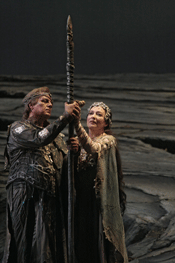 Albert Dohmen as Wotan and Yvonne Naef as Fricka [Photo by Beatriz Schiller courtesy of The Metropolitan Opera]
Albert Dohmen as Wotan and Yvonne Naef as Fricka [Photo by Beatriz Schiller courtesy of The Metropolitan Opera]
Third, you need a cast, especially a Wotan, a Brunnhilde, a Siegfried
— though I’m with Wagner: there are no small parts. (The
Rhinemaidens and Norns in this Ring proved that quite well.) Rather to
my surprise, this was one of the best Rings for all-around singing of
recent decades, even if it lacked the superlative Brunnhilde and Siegfried we
all sigh for. First, the Wotan — Albert Dohmen, who has sung Wotan at
Bayreuth, Vienna, Berlin and places like that, took over the part for, we
assumed, a first essay to succeed the aging James Morris’s well-known
interpretation. Who remembers how incredulous everyone was when Morris, a bel
canto and Mozart specialist, first took it on? I do — in San Francisco,
1985 — and how excited we all were by the beauty of his way of doing
things. Now, he seems to have been doing it forever, and I was foolishly
surprised that Dohmen gave us so mature, so satisfying Wotan, different but
equal. Dohmen’s singing of the part was audibly nastier and less sane
than Morris’s bel canto shimmer, but full-voiced and thrilling —
his own version, and a clear one. (And the loudest Wanderer I’ve ever
heard.)
For the second cycle, erstwhile mezzo-soprano Katarina Dalayman sang the Brünnhildes of Die Walküre and Götterdämmerung, with far better command of the soprano tessitura than her Isolde demonstrated last winter, lovely bursts of warm sound, spectacular power in moments of high emotion, and a genuine trill in Act II of Götterdämmerung — besides looking rather fetching in those oddly-hemmed buckskin shmattas. (During the first season of this production, a friend whispered, “Barbara Mandrell would kill for that outfit.”) Unfortunately, Linda Watson sang the higher Brünnhilde of Siegfried with a shriek that blistered the pine trees — when she opened her mouth, you never knew what would come out, but very little of it gave pleasure. At that, a Ring with only half an act where you cringe is a pretty impressive Ring, and the previous two and a half acts may have been the best Siegfried of my experience of that least loved work of the tetralogy.
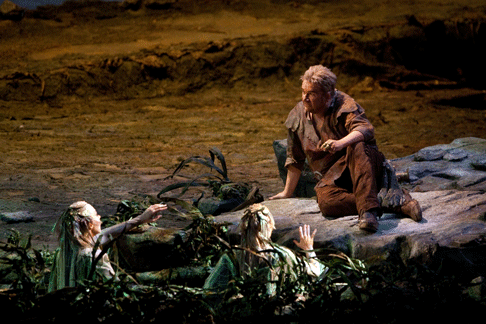 Christian Franz as Siegfried and the Norns [Photo by Marty Sohl/Metropolitan Opera]
Christian Franz as Siegfried and the Norns [Photo by Marty Sohl/Metropolitan Opera]
Siegfried was sung by Christian Franz. He does not have the ideal physique for the role (he was shorter than Alberich) nor the ideal, tireless voice, but he is a talented, intelligent performer — his playing of the naïve, good-natured hero was charming, bumptious, in perfect character — I especially enjoyed his “Hey-I’m-here-too” wave at newly-wakened Brunnhilde, as she ignored him to salute the sun. He seemed tickled just to be Siegfried, and to be living Siegfried’s life — which is the figure Wagner wanted. And his skill when his voice audibly ran out of steam, at speaking or half-singing certain lines effectively, never left us in doubt that we would have a performance, whatever happened. It was very professional work, and in his better-rested scenes, musical as well.
Among the other excellent performers, top marks go to Yvonne Naef’s regal Fricka and, even more, her desperate, impassioned Waltraute (has one seen so intense a Waltraute? Even Troyanos?). It was a pleasure to hear the Nibelung brothers sing their music, instead of the usual whine and croak, and singing is what we got, with no loss of drama, from Richard Paul Fink’s nasty, gnome Alberich, and from Tom Fox, who took over the part in Siegfried, and also, top honors, Robert Brubaker’s fluttery, adorably creepy Mime. Rheingold also gave us Kim Begley’s fine, sleazy Loge and the underutilized Charles Taylor as a princely Donner — who ever notices Donner? Well, everyone noticed, and heard, this one, swinging his hammer like an Olympic athlete and tossing his voice about with similar power. René Pape sang a lovable Fasolt and a bitter Hunding; Iain Paterson a good Gunther; Margaret Jane Wray a stalwart Gutrune (but is the Met ever going to employ her as anything else? I’ve heard her splendid Sieglinde, but only in Seattle). John Tomlinson, who has been singing Wagner leads even longer than James Morris, was in total control of Fafner’s heavy lines, but also made a memorable Hagen — I’ve never seen that dour part done with such glee, as such a merry old elf — you thought he was going to put Siegfried on his knee and ask him what he wanted for Yule — and then not give it to him. Like Franz, he sometimes shouted lines he can no longer sing mellifluously, but he’s an actor, he made it work for him, and it’s somehow even more horrible to have Mr. Jolly stab the hero in the back than the usual grim hit man.
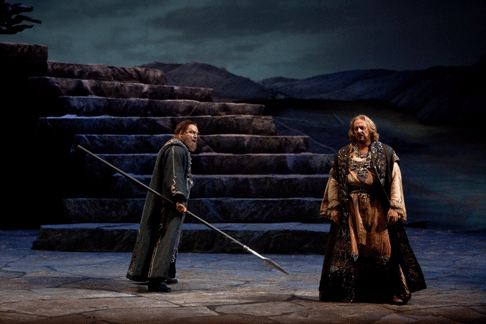 John Tomlinson as Hagen and Iain Paterson as Gunther [Photo by Marty Sohl/Metropolitan Opera]
John Tomlinson as Hagen and Iain Paterson as Gunther [Photo by Marty Sohl/Metropolitan Opera]
From the many ladies in supporting roles, one might single out Kate Lindsay among the Rhinemaidens and Wendy Bryn Harmer as the soprano Norn, but these were standouts in absurdly good trios. The valkyries were fun, too — and hardly louder.
Slightly less deserving of the highest praise, but still worthy of a great Ring in a great opera house, were Wendy White’s pleasing but not deeply compelling Erda (in a costume that made her look like Amneris in a 1900 production of Aida) and Adrianne Pieczonka’s Sieglinde — beautifully acted and, on the whole, sung, but her lovely voice weakens on top, turning a bit white at moments of excitement, and there were gleams of wobble in her narration.
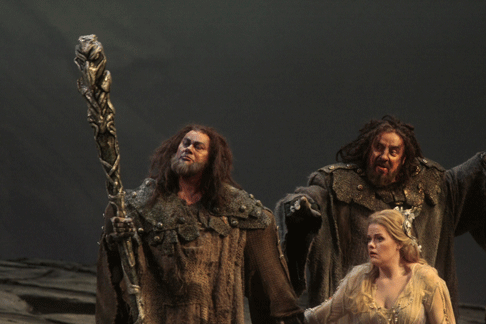 René Pape as Fasolt, John Tomlinson as Fafner and Wendy Bryn Harmer as Freia [Photo by Beatriz Schiller/MetropolitanOpera]
René Pape as Fasolt, John Tomlinson as Fafner and Wendy Bryn Harmer as Freia [Photo by Beatriz Schiller/MetropolitanOpera]
Plácido Domingo cannot persuade the Met to lower Siegmund’s music a tone, as he often does in Italian roles, and his German sounds a bit like Spanish, but he did get through it — partly, it seemed, by rushing when he was short on breath, obliging his old friend Maestro Levine to hurry the pace as well. Yes, he’s a miracle, and he plays this life-battered hero well, but it might be time to call it a career, at least as a Wagner tenor. (Has anyone noticed that that ghastly painting of him in “Roman” costume at the top of the grand staircase, all shoulderpads and helmet, resembles an ice hockey goalkeeper?)
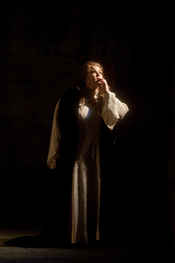 Margaret Jane Wray as Gutrune [Photo by Marty Sohl/Metropolitan Opera]
Margaret Jane Wray as Gutrune [Photo by Marty Sohl/Metropolitan Opera]
The only singers really not worthy of a great Ring were Watson and
the tenor playing Froh. When did you last attend a Ring where only
Froh and the last twenty minutes of Siegfried made you wince? This was
a joyous and memorable week, with too many exquisite moments to enumerate, too
many times Wagner and his interpreters seemed to be doing everything right,
when you didn’t want to be anyplace else on earth.
There is no one way to stage any opera, and the Ring offers more interpretative opportunities than most, than almost any. You can be literal — but that’s not done much any more. You can be mythic or ethnic or archetypal or economic or historicist or very very dark (I have seen all these done) or you can impose your own artistic méthode on the matter (as Robert Wilson did in Zurich lately) or deconstruct the thing (as in Weimar last month) or do it in concert. The winged helmets and ladies in steel exoskeletons that were so novel in Wagner’s day are now a deathless cliché — the Met brought them back for its recent 125th anniversary gala, arguing — as can hardly be doubted — that almost no one going to the opera today has ever seen such things, and that everyone would be thrilled to do so, at least once. Actually, that’s not quite true — we’ve all seen ladies in winged helmets and hubcab brassieres — but we’ve seen them in automobile commercials, satirical skits, comic books, in parodies like Gilbert and Sullivan’s Iolanthe or as a walk-on in The Ghosts of Versailles — few people have seen such things in an actual Ring.
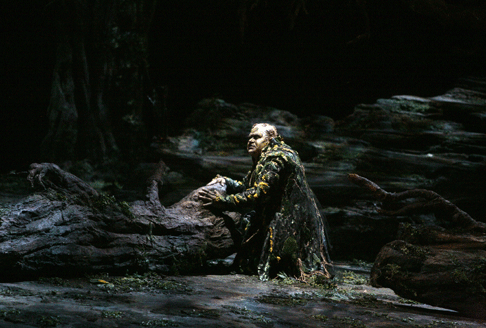 Richard Paul Fink as Alberich [Photo by Beatriz Schiller/Metropolitan Opera]
Richard Paul Fink as Alberich [Photo by Beatriz Schiller/Metropolitan Opera]
This is a major reason why the Met first decided to do an old-fashioned scenic Ring — because no one else does it that way any more (least of all Bayreuth, or anywhere else in Germany), and their judgment was sound. Every Wagnerian the world over (and that’s a lot of people) would love to see it done that way, just once (some of them would like to see it that way every time), and the fact that the Met does three cycles every three years (as has been the custom since this production was inaugurated, twenty years ago) is a great lure. This year, I ran into visitors who’d come from Melbourne and Budapest and Hong Kong and Zurich; I overheard conversations in Russian and German and French and Italian, and several languages I don’t know. There is an audience for the fairy tale treatment — whereas, if it’s motorcycle helmets, and ladies in fishnet stockings and spike heels, and gods (or Norns) reading the newspaper, and Alberich beating off in a trench coat, and a mechanical dragon — we’ve all seen that. We’ve seen it, seen it, seen it. It’s a damned boring way to do opera — the way everyone else does it now.
The Met’s old-fashioned productions are a major tourist draw. They make the Met stand out as its repertory and singing roster no longer do. And the audience they draw is very broad. A woman said to me that she felt quite young at this Ring — she was my age, which is not young — because so many far older folk were there. And there were. But the house was also packed with young people, kids brought by parents, 20-somethings and 30-somethings, on dates or showing off elegant new clothes or seeing that real music-lovers don’t always need to wear elegant clothes to go to the opera, and they were really grooving on it. Is this a Tolkien movie spinoff crowd? Or young people sick of CGI and sampled beats who want to hear real voices and real instruments, unfiltered by electronics for once? No idea, I didn’t ask, but it’s a fine sight at the Met, where these youngsters are imbibing the lesson that opera can be a thrill, and the Met is not a forbidding place to go. The Gelb administration gets much kudos for drawing them in, by whatever means: the Wagnerians of the future.
John Yohalem
image=http://www.operatoday.com/Dalayman_Brunnhilde.gif image_description=Katarina Dalayman as Brünnhilde [Photo: Marty Sohl/Metropolitan Opera] product=yes product_title=Richard Wagner: Der Ring des Nibelungen product_by=Wotan: Albert Dohmen; Fricka and Waltraute: Yvonne Naef; Alberich: Richard Paul Fink/Tom Fox; Loge: Kim Begley; Erda: Wendy White; Donner: Charles Taylor; Fasolt and Hunding: René Pape; Fafner and Hagen: John Tomlinson; Mime: Dennis Petersen/Robert Brubaker; Brünnhilde: Katarina Dalayman/Linda Watson; Siegmund: Plácido Domingo; Sieglinde: Adrianne Pieczonka; Siegfried: Christian Franz; Forest Bird: Lisette Oropesa; Gunther: Iain Peterson; Gutrune: Margaret Jane Wray. Metropolitan Opera, conducted by James Levine, performances of April 27, 28, 30 and May 2. product_id=Above: Katarina Dalayman as Brünnhilde [Photo: Marty Sohl/Metropolitan Opera]Canadian Opera on the rise
Toronto’s Canadian Opera Company overwhelmed its audience with just such perfection in the production of Verdi’s Simon Boccanegra that opened the company’s spring season in the still-new Four Seasons Centre for the Performing Arts.
The staging, new at London’s Covent Garden a year ago, was directed by Ian Judge, who in addition to his credentials as one of today’s top international directors of opera, looks back on a quarter century with England’s Royal Shakespeare Company. Although the libretto for Boccanegra is largely by Francesco Maria Piave, Judge brought the insights of a major Shakespearean to Verdi’s 1881 revision of the work, first staged in Venice in 1857.
Judge has a strong sense of dramatic flow of “Boccanegra” and thus eschewed the divisions into acts and the in-between-curtains that traditionally interrupt it. With a single intermission after the curse that ends the Council scene, this was a staging, seen on May 3, that kept the audience almost breathlessly engaged throughout its three hours.
In the title role Italy’s leading Verdian Paolo Gavanelli headed a cast without a weak link. Especially for those who saw Dmitri Hvorostovsky in this role in San Francisco last fall, Gavanelli brought a new depth to the role.
Minus the Russian’s Hollywood handsomeness, Gavanelli’s Boccanegra was good generation older than the man played by Hvorstovsky. The result was a man of greater seriousness and experience, indeed a man Lear-like in his dignity and suffering. Vocally Gavanelli set the standard for the rest of the cast. Tamara Wilson, a young American soprano from Houston’s studio program, played Maria as a woman both intelligent and vulnerable and handled high notes with power or delicacy — as the moment demanded.
Canada’s Phillip Ens was impressive as Fiesco, and Russian Mikhail Agafonov was his equal as Adorno. Marco Guidarini, respected as a Verdi conductor throughout Europe, displayed a fine sense for both music and drama in his work with the COC’s excellent orchestra. And the chorus, rehearsed by Sandra Horst, was fully caught up in the drama.
Sets by John Gunter were traditional with touches of modernity in sloping walls and a titled pillar. Lavishly rich costumes were by Deirdre Clancy. Nigel Levings was responsible for unusually effective lighting.
Judge brought Shakespearean majesty to the death of Boccanegra, an aspect clearly in the mind as he indicated in a program note on the opera: “It has all the qualities of a Shakespeare play. Verdi loved Shakespeare. He wrote [here] a Shakespeare drama in his own way, and that’s what is terrific.” This was indeed and in every way a terrific Boccanegra!
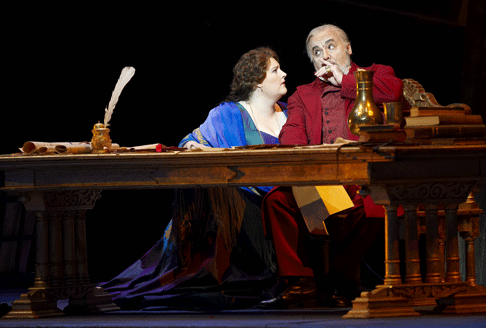 Tamara Wilson as Maria Boccanegra and Paolo Gavanelli as Simon Boccanegra
Tamara Wilson as Maria Boccanegra and Paolo Gavanelli as Simon Boccanegra
All in all, this production, although planned when the late Richard Bradshaw was still COC CEO, speaks highly of the commitment to continuing excellence by new general director Alexander Neef and recently appointed music director Johannes Debus. (Bradshaw had filled both offices.)
Second triumph of the COC spring season was Benjamin Britten’s Midsummer Nights Dream in a co-production with Houston Grand Opera, seen on its opening night May 5. For the staging of the 1960 work designer Dale Ferguson — responsible for both sets and costumes — created a dreamscape that drew the capacity audience into the world of enchantment that Britten made of Shakespeare’s drama.
Animation was brought to the diaphanous set in spring-like shades of green by an immense “sleep sheet” that spanned the stage and descended on Britten’s characters when they truly slept. Ferguson’s richly imaginative land — upside-down trees decorated the set — provided an ideal environment for the ethereal singing that distinguished the production.
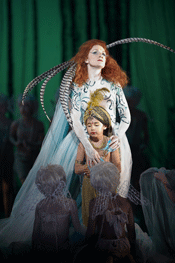 Laura Claycomb as Tytania
Laura Claycomb as Tytania
As Tytania and Oberon, rulers of the fairy world, Laura Claycomb and
Lawrence Zazzo led the large cast that was superb in both serious and comic
moments. Texan Claycomb, of course, is a leading figure on the international
opera scene, and with her often buoyant chiffon train was a major force in
making this production a transcendent experience.
And Zazzo, confined for the most part to a gondola swinging above the stage, sang with a voice of unusual resonance that places him a step above the many countertenors on stage today. Mezzo Kelley O’Connor, famous for her performances of Peter Lieberson and Oswaldo Golijov, was a beautiful Hippolyta, perfectly partnered by Robert Gleadow as Theseus.
Adam Luther (Lysander), Elizabeth DeShong (Hermia), Wolfgang Holzmair (Demetrius) and Giselle Allen (Helena) — excellent all — completed the company of confused lovers. The rustic troupe responsible for the play-within-the-play in Dream was delightfully led by Thomas Goerz, while Robert Pomakov was a touching Bottom. As Flute, the role written for Peter Pears, Lawrence Wiliford recalled that Britten wrote his bel canto aria as a send-up of Joan Sutherland, whom he had recently heard as Lucia.
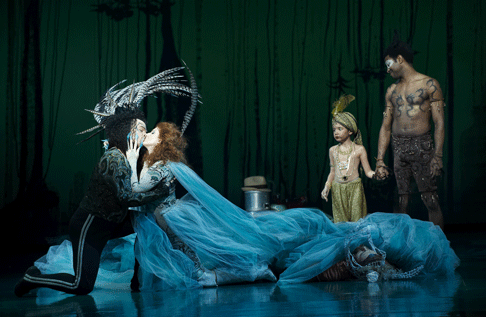 (l - r) Lawrence Zazzo as Oberon, Laura Claycomb as Tytania, Robert Pomakov (lying on ground) as Bottom and Jamaal Grant as Puck
(l - r) Lawrence Zazzo as Oberon, Laura Claycomb as Tytania, Robert Pomakov (lying on ground) as Bottom and Jamaal Grant as Puck
Jamaal Grant played Puck — a speaking role — with the joy of the prankster that the character is. Of special distinction was the contribution made to the staging by the well-trained children’s choir.
Director Neil Armfield and conductor Anne Manson worked together to underscore the need for a proper balance of foolishness and gravity in the opera — and in life.
Damien Cooper’s sensitive lighting added to the magic of this exemplary production.
Given the admirable quality of these two productions, it is difficult to understand that the COC could allow itself the embarrassing mediocrity of the Bohème that completed the company’s spring season.
The revival of the company’s traditional 2005 staging — sets and costumes by, respectively, Wolgang Skalicki and Amrei Skalicki — was cast largely with alumni of the COC Ensemble Studio now singing with Canada’s regional companies.
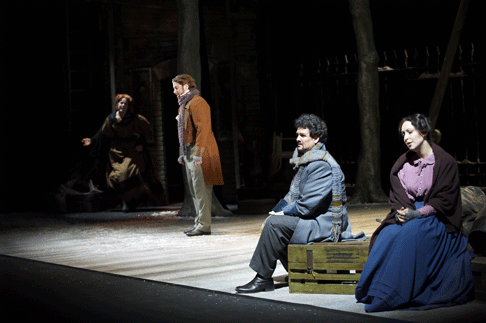 Anna Leese as Musetta, Peter Barrett as Marcello, David Pomeroy as Rodolfo and Frédérique Vézina as Mimì
Anna Leese as Musetta, Peter Barrett as Marcello, David Pomeroy as Rodolfo and Frédérique Vézina as Mimì
David Pomeroy (Rodolfo), Peter Barrett (Marcello), Peter McGillivray (Schaunard) and Frédérique Vézina (Mimì) all failed to make emotional contact with the roles they sang.
Better qualified for her assignment as Musetta was New Zealand’s Anna Leese, yet she too was painfully over- directed by Maer Gronsdal Powell, heretofore assistant to numerous directors of COC productions.
On her own here, Powell was at a loss for meaningful ideas that might have brought a dramatic impact to the staging that ran its course with no sense of direction. And COC Derek Bate, on the podium on May 4, chose for the final act a dirge-like tempo that left one wondering whether Mimi was going to live forever after all.
Hard as it is to imagine a Bohème that leaves an audience dry eyed, that was the unhappy case here.
The Canadian Opera Company now ranks sixth among opera companies in North America. Statistics provided by Opera America list the six first in terms of budget: the Met, $252 million, San Francisco Opera, $70 million, Chicago Lyric Opera, $54.3 million, Los Angeles Opera, $51 million, and New York City Opera, $42 million. And in number of performances, the COC with 68 slated for the up-coming season, is third after the Met with 225 and Chicago with 72.
In the past two seasons — this is the third in Toronto’s Four Seasons Centre — the COC has played to 99% of capacity houses, which is the record in North America. In Chicago it has been 93%; at the Met, 90%. In the same period the COC’s annual subscription rate has been 75%, again a North American record. In Chicago the average is 68%; at the Met, 32%.
The COC is clearly a company on the rise!
Wes Blomster
image=http://www.operatoday.com/simon04_COC.gif image_description=Tamara Wilson as Maria Boccanegra [Photo by Michael Cooper courtesy of Canadian Opera Company] product=yes product_title=Canadian Opera on the rise product_by= product_id=Above: Tamara Wilson as Maria BoccanegraAll photos by Michael Cooper courtesy of Canadian Opera Company
Subtle Previn world premiere in Houston
Where the German-American composer’s oeuvre will rank among the other thirty eight remains to be seen, but its subtly gives it a shot at longevity its predecessors didn’t enjoy.
Based jointly on the Noël Coward play Still Life and the 1945 film from which the opera took its title, Brief Encounter is a simple story. Two married parents, Laura (soprano Elizabeth Futral) and Alec (baritone Nathan Gunn) run into each other in a train station. Since Laura makes a trip to the city where Alec works once a week, the pair fortuitously find each other several times and develop an infatuation that turns into an affair. Both struggle with the moral implications of their relationship, and Fred, Laura’s loving yet aloof husband (sung by bass-baritone Kim Josephson) remains ignorant to her deception. Ultimately, the couple ends the fling for their families’ sake, not for a lack of mutual desire.
As theater, Brief Encounter didn’t qualify as compelling drama. The story began in an anachronistic fashion, amid the final goodbyes after the couple ended the affair—Laura then told the story of what preceded the farewell. Yet after the two hour opera finished and the story was recounted, nothing really had happened. Part of the problem is that no one cared about their affair—the only “risk” the couple faced was their own internal strife. Once Fred sensed something different in Laura, the opera was almost over and Laura had long since decided not to continue the affair. Over the course of the performance, the lovers talked about themselves, talked about their affair, talked about their families, kissed once, and then talked some more. Despite all this talking, the characters weren’t developed—they seemed only to have relevant existences within the context of the affair. John Caird’s odd libretto didn’t help much, seeming at times more like a movie script than an operatic text: on more than one occasion Previn’s music leaned towards a deliberate, romantic sound while the lovers sang verbose, chatty lines. Caird also ended several scenes with trite, pithy emotional outbursts that watered down any real sentiments the characters expressed.
Previn’s occasionally dense instrumental orchestration firmly fits in the through-composed film score tradition of the 1940s and 1950s. The German-American composer utilized a litany of styles in this mostly tonal opera, none of which overpowered the others. The vocal line, however, was more difficult to categorize. Futral had several ariosi where she showed soaring fortissimi and dramatic pathos, yet in other sections (notably her scenes with Gunn), the vocal construction resembled very light musical theater composition. Previn’s score included much swelling in the strings with very little release, mirroring the events on stage. In the end, the orchestra served a bel canto function of supporting the singers without drowning them out or drawing attention away from their lines. It would be difficult to pinpoint any outstanding suites or excerptable arias, but in the end that may very well be how Previn sees the story. Not a lot happens in Brief Encounter, musically or dramatically. Alec and Laura are restrained, always bordering on allowing themselves to give in to their desires. A score that somehow indicated a world that contradicted their own would be confusing. Theirs is a subtle environment—a world of coming home to children and spouses with little to no excitement, just steady presences. The steady presence of Previn’s orchestration mirrors this reality throughout the opera.
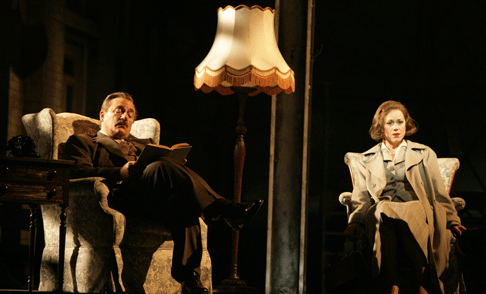 Laura (Elizabeth Futral) and Fred (Kim Josephson) [Felix Sanchez, Courtesy of Houston Grand Opera]
Laura (Elizabeth Futral) and Fred (Kim Josephson) [Felix Sanchez, Courtesy of Houston Grand Opera]
Futral as Laura gave a splendid performance, although she pushed during some of her heavier sections. Nathan Gunn’s Alec was not seductive vocally or theatrically—he was a regular man in love with a regular woman. At times out of place in large scale works, Gunn disproved any critics by giving a smooth, clear performance that never resorted to blustering. Despite the strange vocal lines, credit should go to Previn for knowing the strengths of these two main characters. Bass-baritone Kim Josephson was a steady presence as Laura’s husband, Fred, providing a more mature voice that contrasted well with Gunn’s lighter baritone. Meredith Arwady as Myrtle Bagot showed a shockingly deep and dark contralto, almost so dark at times as to lose clarity. All cast members could have worked a little more on their English diction, though. The confusing half-American-half-English accents resulted in more than several indistinguishable phrases. Music director Patrick Summers led an appropriately restrained performance and showed much deference to Previn during the curtain calls.
The most innovation was shown by the direction and design team of John Caird (who directed in addition to writing the libretto), Bunny Christie (set/costumes), and Paul Pyant (lighting). The train station where Alec and Laura first meet served as the backdrop for the rest of the production, with elegant, seamless sets dropping in from above to create Laura’s home, a public plaza, a boathouse, and a riverbank. Extensive use of fog kept the train station theme present, and (very loud) dry ice machines created a believable river setting. Christie’s assignment was not easy—over eight scenes in the eighty minute first act alone—but his scene changes were fast, credible, and not distracting. Pre-war furniture and costumes were utilized well, inculcating the subtle lives led by the characters. Nothing stood out, but that was the point—these stories could happen to anyone, anywhere.
Brief Encounter isn’t the next great American opera. It is, above all, a subtle work that serves as a snapshot of the lives of two everyday people. The fact that it doesn’t resort to heavy drama makes it somehow more relevant, though, and Previn’s orchestration underscores this fact. Opera can be subtle, and so can the stories the art form relates. Brief Encounter gets that point across, to an overall positive effect.
Paul Wooley
image=http://www.operatoday.com/BriefEncounters01.gif imagedescription=Laura (Elizabeth Futral) and Alec (Nathan Gunn) in Brief Encounter [Photo by Felix Sanchez, Courtesy of Houston Grand Opera]
product=yes producttitle=André Previn: Brief Encounter productby=Laura Jesson: Elizabeth Futral; Alec Harvey: Nathan Gunn; Fred Jesson: Kim Josephson; Dolly Messiter: Rebekah Camm; Myrtle Bagot: Meredith Arwady; Albert Godby: Robert Orth; Dr Graves: James J. Kee; Mary Norton: Jamie Barton; Ms Rolandson: Faith Sherman; Stanley: Adam Cioffari; Beryl: Alioia Gianni. Conductor: Patrick Summers. Director: John Caird. Set Designs: Bunny Christie. Costumes: Bunny Christie. Lighting: Paul Pyant. product_id=Above: Laura (Elizabeth Futral) and Alec (Nathan Gunn) in Brief Encounter [Photo by Felix Sanchez, Courtesy of Houston Grand Opera]
The Tuscan Convent Where Wagnerian Singers Are Trained
As a matter of fact, if you go there you not meet neither Amfortas nor Gurmenanz , but young singers studying Wagnerian roles in the “Accademia di Montegral”. The Academy was established some 22 years ago by Gustav Kuhn (a very well-known Austrian conductor who specialized in Wagner and Strauss, but not disdain Mozart and Verdi). Kuhn also loves Italy where has been Artistic Director of the Rome Opera House, the Sferisterio Festival and a star of the Rossini Opera Festival and of the San Carlo Theatre in Naples. The Academy is financed by a local savings and loans association and by a number if Austrian firms. In the Convento dell’Angelo , both an impressive monastery built by the Padri Passionisti and a pleasant and peaceful environment in which the artists can concentrate on their work, there also an annual chamber music festival , organized with the support of Col-Legno records (www.col-kegno.com). The next festival runs from May 14 to May 18; it offers a combination of classical music (from Bach to Puccini) and contemporary authors (Eggert, Ligeti): on Sunday May 18th, the Holy Mass will be accompanied by Rossini’s Petite Messe Solennelle; for information, www.montegral.com. In the Summer, there is a Festival in Tyrol, in the spectacular Passion Music Center of the small town of Erl (80 km from Munich and also, but in a different direction, 80 km from Salzburg). For several year the main feature has been a low cost but good quality production of Wagner’s Ring (www.tiroler-festpiele.at) . Next July, the Gods and the Nibelungs will take a rest, but there will be an exciting new production of Strauss’ Elektra which, for the first time in years, will be performed without the usual deletions and abbreviations.
The other new production is Meistersinger von Nürnberg, directed and conducted by Kuhn The costumes will be designed by the artistic manager of the costume manufacturing Lenka Radecky A new member of the team is the international sought-after architect and stage designer Jaafar Chalabi whose works for the Company of Nacho Duato in Madrid, Paris and Moscow. Matthew Best, a Heldenbariton for the great Wagner and Strauss operas, will give his first Hans Sachs. Michael Baba will be heard as Walther von Stolzing. The cast of another leading part means a connection to Erl: the international acting singer Martin Kronthaler will return to his hometown and perform Sixtus Beckmesser in Wagner’s opera.
Giuseppe Pennisi
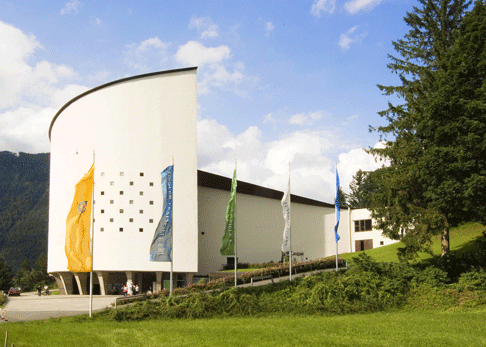 Passionsspielhaus Erl [Photo © TFE]
Passionsspielhaus Erl [Photo © TFE]
image=http://www.operatoday.com/ElektraErl.gif imagedescription=A scene from Elektra [Photo courtesy of Tiroler Festspiele Erl]
product=yes producttitle=The Tuscan Convent Where Wagnerian Singers Are Trained productby= product_id=Above: A scene from Elektra [Photo courtesy of Tiroler Festspiele Erl]
Verdi and Boito at the Rome Academy of Santa Cecilia — Angels and Demons in an Unusual Setting
In addition, Maestro Antonio Pappano gave to the concert a title quite similar to that of the movie: “Angels & Demons”. This did ingenerate some confusion in the press. Opera Today seldom deals with symphonic concerts. However, this was a very special opportunity: an appetizer of what Pappano could do if he would conduct a fully fledged performance of Arrigo Boito’s Mefistofele. I do not know whether Pappano has ever conducted the full opera in a stage performance.
Mefistofele is an “opéra maudite”, viz . an opera over which a bad spell seem to hang . It was a fiasco when his 7-hours-plus first version was premiered on March 5 1868. It was a major hit when drastically revised, the present version (about two and a half hours of music) was stage on October 4 1875 in Bologna. This second version was successful nearly until World War Two. Then, it disappeared nearly all over. In the USA, I remember a good production constructed by the York City Opera around the bass Norman Triegle in the 1970s. In Italy, only a few conductors (Riccardo Muti, Stefano Ranzani, Nicola Colabianchi) appear to like it. A few years ago Mefistofele was produced at La Scala but only for a few performances. In 2005 it was on the stage of the small Maruccino theatre of a little provincial town, Chieti; there Maestro Colabianchi took up the challenge. A few months later, Maestro Muti conducted two open air concert performances of excerpts of the opera in Ravenna and Tunisia. In 2007, a glittering Giancarlo Del Monaco production inaugurated the season of the Palermo’s Teatro Massimo with Maestro Ranzani in the pit.
I consider Mefistofele an uneven masterpiece , the only real attempt - with the second part of Mahler’s Eighth Symphony - to capture the spirit of Goethe’s poetry. Of course, only an attempt due to the immensity of Goethe’s Faust. There are naïve parts and uncertainties - something rough, not fully polished. But this adds to its charm.
Even in the decades when Mefistofele was hardly seen on stage, “The Prologue in Heaven” was often performed as a concert piece. It is a 25 minutes superb summary of what will happen next in the opera. Maestro Pappano , and the orchestra and chorus of the Santa Cecilia chorus- as well as the Rome children chorus - provided a real heavenly panoply in the opening of the “The Prologue”. The trumpet fanfares were sumptuous, the percussion thunderous, the brass and harps angelic: the audience felt to be in the Celestial Heights. Then with arrival of the Uruguayan bass Elwin Schott and his sarcastic and burlesque “Scherzo” we were taken down- to Hell. Schott is a bass with a well-tempered timbre; his grumblings sound even more blasphemous than in Triegle’s or Furlanetto’s performances. Pappano , the orchestra and the double chorus reach solemnity in the “Chorus Mysticus” scene immediately followed by a sharp confrontation in the challenge scene to ascend again to Celestial Heights when the Cherubins arrive and chase the tempter. A vibrant full of fire conducting which makes me ask for more, for a full production. The concert hall has 2800 seats ; the audience was enthusiastic.
Mefistofele’s “Prologue” was precede by a rarely performed Verdi’s Te Deum . Verdi was a tormented atheist, whilst Boito was a deeply rooted and contented atheist. His Te Deum is a late composition - first performed in 1898 when he was well in his 80s. It was not an old man’s search for after-life-peace. With a bit of irony , Verdi wrote that it was meant as the Audience’s (with capital “A”) Thanksgiving for not having to listen to his opera any longer . Twenty years after his Requiem, Verdi is back in Church but once more, like in a melodrama his music deals with human, very human passions more than with Godly feelings. The Chorus is a grand-opera chorus counterpointed by a soprano voice and a masterly orchestration . Pappano is, first of all, an operatic conductor. Hence his highly dramatic.
The initial part of the concert was Beethoven’s First Symphony. Pappano lengthened the tempos: the symphony lasted nearly 45 minutes instead of the 30-35 in most recorded performances . He added pathos in the “adagio” and “andante con brio” but last the Haydn’s and Mozart’s XVII century elegance in the “minuetto”.
Giuseppe Pennisi
image=http://www.operatoday.com/ErwinSchott.gif imagedescription=Erwin Schott [Photo by Riccardo Musacchio and Flavio Ianniello]
product=yes producttitle=Ludwìg van Beethoven: Symphony n. 1; Giuseppe Verdi: Te Deum; Arrigo Boito: Mefistofele Prologo in Cielo productby=Erwin Schott, bass; Donika Mataj, soprano. Orchestra and Chorus of the Accademia di Santa Cecilia Children Chorus of Accademia di Santa Cecilia e Teatro dell’Opera di Roma Band della Guarda di Finanza. Conductor: Antonio Pappano. product_id=Above: Erwin Schott [Photo by Riccardo Musacchio and Flavio Ianniello]
Lady Macbeth of Mtsensk — Opera Australia
With simultaneous premieres in Leningrad and Moscow followed, at one point, by simultaneous productions in three Moscow theatres alone foreign productions followed. After the American premiere the sensational opera became topical enough to be mentioned in the Rodgers and Hart musical On Your Toes and in London, where it was performed in concert in 1936 followed by BBC broadcast, the young Benjamin Britten heard it and was impressed by its powerful interludes (and also by one of the singers, Peter Pears, who had a minor role). The came Stalin’s visit to a performance in Moscow and the subsequent attacks in Pravda on the opera, the ballet The Limpid Stream and the composer himself. The opera was withdrawn immediately. There was difficulty obtaining the music for that London concert in 1936 and after then it disappeared from every stage until 1959 when the Dusseldorf Opera managed to wrangle the orchestral music from the Soviet authorities. By then Shostakovich was testing the waters: Stalin had died and Kruschev had made public the extent of Stalin’s terror: by issuing a revised version of the opera. Only slowly, and not until after Shostakovich’s death, did the original version regain its fame.
For Opera Australia’s production, director Francesca Zambello updates the story to the Soviet era where overbearing male sexuality is just another form of oppression. The bored and sexually unfulfilled Katerina (Susan Bullock) is married to an impotent weakling Zinovy (David Corcoran) while all around her there is an environment of rampaging male sexuality. Even her lecherous father-in-law Boris (Daniel Sumegi) constantly prowls around her bedroom fantasising about doing Zinovy’s matrimonial duty for him.
After seventy years Shostakovich’s music is still exuberant and irreverent but with astonishing power in places, like those cathartic interludes that so impressed Britten. The first two acts, leading up Katerina and her lover Sergei (Richard Berkeley-Steele) murdering her husband seethe with threatening or raucous music that explode in the scenes of sex or violence that are still very confronting. In the opening scene trombones blurt slyly as Boris insinuates that she is looking for a lover and again in a later scene when he predicts her infidelity. Finally, alone in her room with Sergei the notorious on-stage sex scene, those trombones now grunt wildly along with every thrust in music that reaches a literal climax and aftermath that has to be heard to be believed! Zambello has their lovemaking as frenzied and confronting as the frenzied music and in the other notorious scene where the cook Aksinya (Jacqueline Dark) is attacked by the workmen is turned into a near mass rape, the near naked workmen groping her and themselves in a scene that begins during the linking interlude where the sleazy music accompanies Sergei signalling the workmen to gather in the wash house and making it obvious the attack is well planned and that Sergei is the ringleader. The coarseness of the male sexuality as played here sets Katerina’s ecstatic sexual awakening in sharp relief. Even though it is very confrontingly depicted it looks positively virtuous in comparison with the Boris and his worker’s lechery.
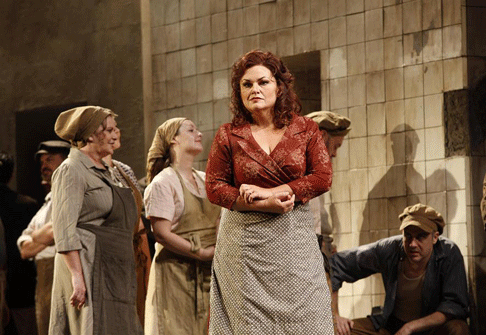 Susan Bullock as Katerina Ismailova [Photo by Jeff Busby]
Susan Bullock as Katerina Ismailova [Photo by Jeff Busby]
Bullock is astounding in this most difficult role. A notable Elektra, her voice rides the huge orchestra in the dramatic scenes with a cut and edge that remains clean and steady at all times. Her recent success in the Chandos recording of Salome, where she scales down her tone to an insinuating whisper is no studio trick either. In the opening scene and later, in the plaintive about animals mating happily but not her, she can spin her voice into a mournful whisper. In the same way she projects the aria in the last act about the black lake out into the auditorium while draining her voice of colour to suggest Katerina numb from both cold and Sergei’s rejection. She acts the highly charged scenes with the same conviction she invests in every other scene right down to weary resignation with which she drowns herself and Sergei’s new mistress. I suspect now that the lulling, romantic and otherwise polite repertoire she chose for her recital was to show her vocal nice side.
Berkeley-Steele copes magnificently the short, jabbing vocal lines Shostakovich gives Sergei, as though he were — appropriately: a cock crowing. Sumegi, looking like Stalin and groping himself as often as his vodka bottle is an unashamedly disgusting Boris. All thee have excellent diction and project the text well.
Sung in English the translation is by the opera producer David Pountney for his English National Opera production which is coy in places other translations are not and forthright in places others are tamer. Katerina’s aria about animals mating, for instance, uses more sexualised language than the translations accompanying either of the two commercial CD recordings of the opera.
The smaller but necessary roles have been cast from strength. Shostakovich drives his buffo tenors hard it seems; the tenor singing the Police Captain in his earlier opera The Nose is required to sing in alt and reach an E above top C. As the shabby peasant Kanen Breen is taxed by the orchestral tsunami Shostakovich sets against the scene in which he discovers Zinovy’s body. As a result he is barely audible against the wild mazurka played forte by the full orchestra and resorts to a frenzied semaphore for the scene.
Deputising for the late Richard Hickox, who was to conduct the Sydney and Melbourne seasons this year, Richard Armstrong had apparently not conducted the work before. With the same authority he brings to Richard Strauss, he scored point after point of the music’s Janus nature, colouring the lyrical passages for Katerina, the quirky but sinister little violin passage as Boris eats the fatal mushrooms and, most importantly, exploding the interludes with shattering force. The orchestra responded superbly to the full barrage of the young and uncensored Shostakovich.
Zambello’s update appears to be roughly the same time that the opera was written. Like Patrice Chereau, who set a trend (most famously in his 1976 Ring cycle at Bayreuth) for setting an opera in the time it was written rather the time it is set, this simple action often contextualises a work in rewarding ways, even without imposing many social or political references from the time. As the Marxist overtones pervaded Chereau’s interpretation of Wagner, the ruthlessness of the purges and oppressions that were beginning in the Soviet Union underpin the story, giving some idea of what was really disturbing to Stalin and his committee. The sudden sighting of a portable television, however, spoiled the otherwise compelling concept. The poverty of regional Russia under Soviet collectivisation was superbly conveyed and gives the Ismailova’s a level of desperation not in Leskov’s original story of comfortable bourgeoisie. Here the sordid environment is both physical and metaphorical.
Michael Magnusson
image=http://www.operatoday.com/Lady_Macbeth_Mtensk_Austral.gif image_description=Susan Bullock as Katerina Ismailova [Photo courtesy of Opera Australia] product=yes product_title=Dmitri Shostakovich: Lady Macbeth of Mtsensk, Op. 29 product_by=Katerina Ismailova: Susan Bullock; Sergei: Richard Berkeley-Steele; Zinovy Ismailov: David Corcoran; Boris Ismailov: Daniel Sumegi; Sonyetka: Dominica Matthews; Aksinya / Woman Convict: Jacqueline Dark; Teacher / Shabby Peasant: Kanen Breen; Steward / Sentry: Richard Anderson; Sergeant / Chief of Police: Richard Alexander; Foreman 1 / Coachman: Stephen Smith; Foreman 2: Graeme Macfarlane; Foreman 3 / Mill-Hand: David Thelander; Porter: Charlie Kedmenec; Priest: Gennadi Dubinsky; Policeman: Shane Lowrencev; Drunk Guest: David Lewis; Old Convict: Jud Arthur. Opera Australia Chorus. Orchestra Victoria. Conductor: Richard Armstrong. Director: Francesca Zambello. Set Designer: Hildegard Bechtler. Costume Designer: Tess Schofield. State Theatre, The Arts Centre 24, 29 April, 2 & 5 May 2009. product_id=Above: Susan Bullock as Katerina Ismailova [Photo courtesy of Opera Australia]Kate Royal at Wigmore Hall
The stimulating programme presented on 7 May, a sequence of 25 songs by Schumann and Brahms devised by the pianist, Graham Johnson, certainly established a cerebral, even ‘spiritual’ mood — ‘serious’ music-making indeed. Regrettably, in the event Johnson was indisposed but, while it took him a little time to become accustomed to the Wigmore Hall acoustic, Christopher Glynn was in no way a ‘second-best’ replacement. His innate empathy with this repertoire was immediately apparent, and his alert responsiveness to the nuances of the texts was sustained throughout the performance.
As the 2004 winner of both the Kathleen Ferrier and John Christie awards, photogenic and market-friendly, 30-year-old Royal has caught the discerning listening public’s ear and eye during the past five years, with acclaimed performances at Covent Garden, English National Opera and Glyndebourne. And yet, while the warm beauty of Royal’s tone and the serious, focused application of an impressive musical intellect were much in evidence during this recital, the end result, while technically skilful and at times emotionally touching, was rather ‘underwhelming’.
On this occasion Royal seemed to take a long time to get into her stride; perhaps this is new repertoire which she has not fully mastered emotionally or dramatically. The opening fours songs by Schumann, selected from his Op.107 set, certainly demonstrated the dark creaminess of the lower range of Royal’s voice, and on the whole the rendering was musically accurate (excepting some wobbles of intonation during dynamic crescendos or peaks); but Royal did not fully convey the full expressive range of the texts.
There is much turbulence in these songs of sadness and loss, which were composed in 1851 - a time when Schumann’s health was deteriorating as the pressures on the newly appointed municipal director of music in Düsseldorf accumulated. The composer’s own psychological instability and subsequent suicide are foreshadowed and embodied; in ‘Herzeleid’, downwards spiralling semiquavers evoke the insanity and death of Ophelia, while the unrequited passion and emotional distress of an unappreciated, overlooked servant girl is conveyed by the dark, descending bass line in ‘Die Fensterscheiber’. Unfortunately, at the start of the recital Royal was rather overpowered by the accompaniment; perhaps she was insufficiently warmed up, but she seemed to lack genuine engagement with these mini-dramas. Glynn tenderly conjured the escalating grief of ‘Die Spinnerin’ and the unsentimental loneliness of ‘Im Wald’, but it was not until ‘Abendlied’ — in which the poet, Kinkel, pleas from his prison cell for a cessation of human fear and misery - that Royal fully realised the despair and anguish in Schumann’s melodic and harmonic gestures. Here, the duo effectively controlled the structure of the song, creating momentum and continuity.
One weakness of the performance was Royal’s diction; consonants were shabbily neglected and there was no real evidence of insight into the texts despite the soprano’s obvious musical intelligence; at times the result was a limited emotional range and a detachment from the emotional core of these lieder. Neither character nor dramatic situation were convincingly conveyed in the Brahms lieder - ‘Liebestreu’, ‘Im der Fremde’, ‘Lied’ (Op.3 Nos.1,5 and 6), ‘Parole’, ‘Anklänge’ (Op.7 Nos.2 and 3) — which concluded the first half; indeed, despite the apparent ease with which Royal surmounted the technical obstacles, it was not until the final song before the interval, ‘Juchhe!’ [‘Hurrah’!] that she got into her stride and began to complement the joyful playfulness and exuberance of the piano’s energetic accompaniment.
Royal seemed more in tune with the emotional sentiments of Schumann’s ‘Gedichte der Königin Maria Stuart’ [‘Poems of Mary, Queen of Scots’ (Op.135)], with which she commenced the second half of this recital. The focused, warm tone of her lower register perfectly communicated the sincere outpourings of the condemned Queen. For this listener, the musical and dramatic peak was attained in ‘Abschied von der Weit’ [‘Farewell to the world’] and ‘Gebet’ [‘Prayer’], where Royal’s controlled lyricism, accompanied by a greater clarity of diction, captured both the sombreness and poignancy of the queen’s last moments. It was an original and striking programming choice to ‘interrupt’ this regal sequence with Brahms’ boisterous ‘Murrays Ermordung’ [Op.14 No.3, ‘The bonnie Earl o’Moray’], a setting of a folk poem in which a queen mourns her clandestine and illicit lover. Again, Royal’s technical assurance fully justified the juxtaposition, as the soprano proved herself able to convey heartfelt regret through a range of idioms.
In the concluding songs by Brahms, Royal finally discovered a dramatic energy and colour which until now had been lacking; ‘Nachtigallen schwingen’ [Op.6 No.6 ‘Nightingales flutter’], ‘Der Frühling’ [Op.6 No.2 ‘Spring’] and ‘Die Trauernde’ [Op.7 Np.5 ‘The sad maiden’] demonstrated that she can produce a myriad of colours to match and enhance the dramatic mood, the effortless melodic sweep and the sheer beauty of her timbre perfectly conveying the lyrical sensuality of these songs. For a singer accustomed to the operatic stage, however, Royal’s lack of physical movement — she scarcely moved her arms throughout these songs, preferring to place the expressive burden solely on the voice — was a little disconcerting. This rather short recital concluded with a single encore, the traditional song, ‘Early one morning’.
So, although there was much to admire, a convincing personal response was not always in evidence during this performance. Royal can without doubt pass the vocal trials but she is not always the mistress of the musico-dramatic challenges.
Claire Seymour
image=http://www.operatoday.com/Kate_Royal.gif image_description=Kate Royal [Photo by Weber] product=yes product_title=Kate Royal at Wigmore Hall, London; 7 May 2009Schumann: 6 Lieder, Op.107; Brahms: Liebestreu; In der Fremde; Lied; Parole; Anklänge; Juchhe!; Schumann: Gedichte der Königin Maria Stuart, Op.135; Brahms: Murrays Ermordung. Nachtigallen schwingen. Wie die Wolke nach der Sonne. Der Frühling. Volkslied. Der Trauernde. Liebe und Frühling I & II. product_by=Kate Royal, Soprano; Christopher Glynn, Piano. product_id=Above: Kate Royal [Photo by Weber]
Janáček: Jenůfa and Kátya Kabanová
Charles Mackerras continues to reign as the supreme conductor of Janáček’s music, and these sets provide further evidence of that, not least by filling up the second discs with other pieces. The Jenůfa set includes the final scene in the revised orchestration that introduced the opera to most of the world, before Mackerras led the return to Janáček’s original score, and the set concludes with an overture considered for the opera but never used. Janáček ‘s Concertino and Capriccio close the Kátya Kabanová set, both in witty performances conducted by David Atherton. The mood of those pieces is quite a bit different from that of the opera, it should be said.
Both sets feature informative essays by John Tyrrell, which give not only detailed background on Janáček’s compositions, including almost academic musical analysis, but also ample information on the original works behind the operas. In the Kabanová booklet Tyrrell’s essay is followed by a note from Mackerras, relating his first exposure to the composer who would become such a large part of his career.
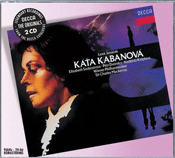 The Kabanová set came in 1978, and its sound world is quite different from that of Jenůfa, composed many years before. The later work comes from the composer’s mature period, and it combines the exciting rhythms and naturalistic declamation found in the earlier work with a richer orchestral fabric, somewhat resembling the textures of his Taras Bulba. However, it seems to be the earlier opera that has established itself as the more performed of the two, undoubtedly due to the power of its story and characters. Both stories deal mainly in pain and distress, but Jenůfa ends with a gorgeous duet of redemptive love, whereas Kabanová’s heroine throws herself into a river, unable to find a way to live a new life or return to her old one. Nonetheless, as pure listening experience, your reviewer finds Kátya Kabanová a more entrancing score to listen to, with its greater variety of tone and mood. Jenůfa, on the other hand, works best on stage, where its characters come to full life, and can break the hearts of most any audience.
The Kabanová set came in 1978, and its sound world is quite different from that of Jenůfa, composed many years before. The later work comes from the composer’s mature period, and it combines the exciting rhythms and naturalistic declamation found in the earlier work with a richer orchestral fabric, somewhat resembling the textures of his Taras Bulba. However, it seems to be the earlier opera that has established itself as the more performed of the two, undoubtedly due to the power of its story and characters. Both stories deal mainly in pain and distress, but Jenůfa ends with a gorgeous duet of redemptive love, whereas Kabanová’s heroine throws herself into a river, unable to find a way to live a new life or return to her old one. Nonetheless, as pure listening experience, your reviewer finds Kátya Kabanová a more entrancing score to listen to, with its greater variety of tone and mood. Jenůfa, on the other hand, works best on stage, where its characters come to full life, and can break the hearts of most any audience.
Elisabeth Soderstrom stars on both sets, her warm, womanly sound appropriate for both characters, and her command of the idiom as sound as her conductor’s. Peter Dvorsky gets to portray both the handsome but weak Steva of Jenůfa and the handsome but weak Boris in the Kabanová. He does so handsomely, with no weakness. Wieslaw Ochman earns his redemption as Laca with urgent, masculine passion. The Kostelnička, Eva Randova, has a full, secure voice, whereas on stage the role is often taken by a veteran singer whose voice may be worn but who can embody the character convincingly. The counterpart role in Kabanová, Kátya’s mother-in-law, is sung with fierce relish by Nadězda Kniplová.
For any opera lover who somehow never managed to acquire these sets in the long years when they were only available at full-price, now is the time to search them out and add them to your collection. Indispensable.
Chris Mullins
image=http://www.operatoday.com/Jenufa4758227.gif imagedescription=Leos Janáček: Jenůfa
product=yes producttitle=Leos Janáček: Jenůfa productby=Elisabeth Söderström, Eva Randová, Wieslaw Ochman, Peter Dvorsky, Wiener Staatsopernchor, Wiener Philharmoniker, Charles Mackerras productid=Decca 475 8227 [2CDs] price=$22.99 producturl=http://www.arkivmusic.com/classical/album.jsp?album_id=168715
Janáček: Kátya Kabanová
Decca 475 7518
Verdi’s Requiem in Santa Fe
In celebration of its twenty-fifth anniversary the first week of May, the Santa Fe Symphony encountered unexpected drama in an attempt — ultimately successful — to present a festive performance of the Verdi Requiem.
First, soprano Kallen Esperian, after several days of rehearsal, came down with laryngitis and canceled Friday noon, with scheduled performances Saturday and Sunday.
Gregory W. Heltman, SFSO’s energetic founding director and manager, contacted General Director Charles MacKay at the Santa Fe Opera to see if his resources included a Verdi soprano on 24-hours’ notice. It so happened MacKay could help. He knew Christine Brewer, a veteran of many a Verdi Requiem, was at her home in suburban St. Louis recovering from a bad knee that kept her out of the Metropolitan Opera’s current Wagner’s Ring cycle. A quick telephone call, a fast favorable decision and the problem was solved. Almost.
Brewer’s plane from St. Louis Saturday morning was due at Albuquerque’s Sunport at 1:20 p.m., presumably allowing time enough to make the 60-mile drive to Santa Fe, check in the Eldorado Hotel, walk across the street to the Lensic Performing Arts Center for a few minutes of rehearsal before dressing for the 6 p.m. concert. But the plane, a victim of weather delays, did not put Brewer on the ground until 4:40, into the awaiting arms of the frantic symphony managers.
After a fast hour’s drive through the rain directly to the stage door of the Lensic in downtown Santa Fe, an intensely focused Brewer headed straight to her dressing room, unpacked her gown, accepted help with make-up, drank a liter of cool water, and was led on stage by conductor Stephen Smith, along with the three other soloists, at 6:40 pm. The audience was ready — they had been kept in place by a lecture and an award made to a venerable music educator.
Brewer looked composed and calm in a black silk gown with a colorful over-cape, and stood next to contralto Kathleen Clawson as if it were business-as-usual, which is about how it turned out, plus a little more. In January Brewer had sung, and recorded, Verdi’s great operatic requiem in England with Sir Colin Davis, and a month later repeated it with the St. Louis Symphony. She had it down cold, and her duets with Clawson were as well-honed as if she had been rehearsing all week. (“We listened to each other,” Clawson later said.) All the soloists’ ensemble work went beautifully, and the “Recordare” was radiant as the two women’s voices blended with rare elegance. Brewer’s fine-spun high tones, one of her great gifts, playing against Clawson’s mature, dark contralto provided an Aida moment, which is perhaps just what Verdi had in mind. Brewer was up to the dramatic requirements of the “Lachrymosa”, and triumphed in the “Libera me” with dramatic parlando outbursts, stunning fortes and ultimately a return to her trademark high pianissimi in the finale.
The last time SFSO essayed the Verdi Requiem was five years ago, the season of its twentieth anniversary, and at that time mezzo-soprano Clawson stood out as the predominant soloist. This year Brewer earned the honors, both for her last-minute effort to save the show, and her supremely refined and confident singing of the challenging soprano lines — pure opera, in effect, by the 19th C. Italian master of dramatic music theatre. Few sopranos I know combine Brewer’s strengths at present — exactly the qualities needed to make memorable this nameless operatic heroine. One has only to experience the “Libera me” as presented by a great dramatic singer to appreciate the generous measure of Brewer’s talent. This was Leonora or Amelia or Aida at her highest emotional pitch. Brewer’s unusually large physical size and a long-held preference for platform singing, will likely continue to keep her from performing staged Italian operatic repertory. Yet, her “Recordare” duet with the mellow Clawson left one yearning to hear these voices in Aida — a frequent point of reference for those who enjoy the Requiem.
Clawson showed a warm rather dark mezzo; if it did not project fully in the lowest register, her tone was plentiful and easy in the middle range and top. She was a worthy proponent of Verdi and partner to Brewer. The male side was a bit less impressive: Robert Bréault, whom I hear as a Britten-Vaughan Williams tenor, was a thorough professional even if his tonal qualities were not of Verdian stripe, and in the bass part Kevin Maynor was similarly earnest if lacking in thunder. Linda Rainey, who is ‘Ms. Choral Director’ of Northern New Mexico, had assembled various forces, the Santa Fe Men’s Camerata, Ken Knight, conductor, and her Santa Fe Women’s Ensemble, which along with the Symphony’s volunteer chorus comprised a group of a hundred singers that was well rehearsed by Rainey and responsive, if not of especially distinguished tonal quality.
Steven Smith, for a decade music director and conductor of SFSO, presented a good standard performance of the Verdi score. Smith has a solid background with the Eastman School and Cleveland Orchestra, and still combines duties in Cleveland with his symphonic concerts each season at Santa Fe, as well as musical direction at the Brevard Festival. We are not talking about a Toscanini fire-and-brimstone Verdi Requiem, rather an affecting and touching reading of the score, well beyond what one might expect to find in a small mountain city in the lower Rockies.
Santa Fe continues to surprise.
J. A. Van Sant © 2009
image=http://www.operatoday.com/Christine_Brewer.gif image_description=Christine Brewer [Photo by Christian Steiner courtesy of IMG Artists] product=yes product_title=G. Verdi: Requiem product_by=Christine Brewer; Kathleen Clawson; Robert Breault; Kevin Maynor. Santa Fe Men’s Camerata. Santa Fe Women’s Ensemble. Santa Fe Symphony Orchestra and Chorus. Steven Smith, conductor. product_id=Above: Christine Brewer [Photo by Christian Steiner courtesy of IMG Artists]May 11, 2009
ROSSINI: Guglielmo Tell — Rome 1954
Music composed by Gioacchino Rossini. Libretto by Étienne de Jouy and Hippolyte-Louis-Florent Bis based on Friedrich von Schiller’s Wilhelm Tell.
First Performance: 3 August 1829, Paris Opéra.
| Principal Roles: | |
| Guglielmo Tell | Bass |
| Arnoldo, Amante Di Matilde | Tenor |
| Gualtiero Fürst | Bass |
| Melchthal, Padre Di Arnoldo | Bass |
| Jemmy, Figlio Di Guglielmo | Soprano |
| Edwige, Moglie Di Guglielmo | Mezzo-Soprano |
| Un Pescatore | Tenor |
| Leutoldo | Bass |
| Gessler, Governatore | Bass |
| Matilde, Principessa Di Hasbourg | Soprano |
| Rodolfo, Seguace Di Gessler | Tenor |
Setting: Switzerland in the 13th century, near Altdorf in the canton of Uri
Synopsis:
Prior to the start of the opera, Arnold, son of the Swiss leader Melcthal, has rescued Mathilde, an Austrian princess, from drowning. In spite of the political situation, Arnold and Mathilde have fallen in love.
Act I
It is the day of the Shepherd Festival, in May, near Lake Lucerne. Per tradition, Melchtal blesses the couples at the celebration. However, Arnold excludes himself from this privilege, as he is torn between his love for his country and his love for Mathilde. Horn fanfares interrupt the festival, and herald the arrival of Gesler, the Austrian Governor, whom the Swiss detest. Leuthold then enters, pursued by Gesler’s forces. One of Gesler’s soldiers has attempted to assault Leuthold’s daughter, and Leuthold killed the soldier to defend her. He wishes to escape, and the lake is the only route. William Tell offers his assistance. Gesler’s guards arrive, led by Rodolphe. Leuthold manages to escape with the help of Tell, but as reprisal, Gesler’s guards take Melchtal prisoner.
Act II
In a valley by a lake, Arnold and Mathilde meet and again pledge their love. Tell and Walter arrive, and inform Arnold that Gesler has ordered the execution of Melcthal. Arnold vows vengeance. Arnold, Tell and Walter swear an oath to liberate Switzerland. They inspire the cantons to unite in this quest.
Act III
At the market-place in Altdorf, the day is the hundredth anniversary of Austrian rule in Switzerland. In commemoration, Gesler has had his hat placed on top of a pole and the Swiss are ordered to pay homage to the hat. Tell arrives with his son Jemmy. Tell refuses to honour the hat. Gesler recognises Tell as the man who saved Leuthold, and wants to punish him somehow. He orders Tell to shoot an apple from Jemmy’s head, in the hope that Tell will harm his son. Tell is successful in piercing the apple, and tells Gesler that had the shot failed, he would have used his next arrow against him. Gesler orders Tell to be arrested.
Act IV
A Swiss rebel army arrives, and battle ensues. Tell kills Gesler with an arrow through the heart. The Swiss emerge victorious. Mathilde and Arnold, secure in their love, reunite at the close.
[Synopsis Source: Wikipedia]
Click here for the complete libretto.
image=http://www.operatoday.com/Schiller_Kuegelgen.gif image_description=Portrait of Friedrich von Schiller by Gerhard von Kügelgen audio=yes first_audio_name=Gioacchino Rossini: Guglielmo Tell first_audio_link=http://www.operatoday.com/Tell1.m3u product=yes product_title=Gioacchino Rossini: Guglielmo Tell product_by=Attilio Barbesi (Leutoldo); Margherita Benetti (Jemmy); Giannella Borelli (Edwige); Mario Carlin (Un Pescatore); Mario Filippeschi (Arnoldo); Antonio Massaria (Melchthal); Angelo Mercuriali (Rodolfo); Anna Rovere (Matilde); Paolo Silveri (Guglielmo Tell); Paolo Washington (Un cacciatore); Nicola Zaccaria (Gessler); Raffaele Arié (Gualtiero Fürst). Orchestra Sinfonica e Coro di Milano della RAI. Nino Sanzogno, conducting. Live broadcast, 30 January 1954, Rome. product_id=Above: Portrait of Friedrich von Schiller by Gerhard von KügelgenMay 7, 2009
Franz Lehár: Das Land des Lächelns
Both men were working on Chinese-themed works in the mid 1020s, and though Puccini did not live to complete Turandot, it premiered in 1926, with Lehar in attendance. Apparently Lehar then went back to an incomplete work, had the libretto revised, and by 1929, Das Land des Lächelns had its premiere. While in form an operetta, Lehar’s Lächelns asks for some strong voices, especially for the lead soprano, who must take the “Calaf”-role of falling in love with Chinese royalty, in this case, a prince named Sou-Chongs. Whereas Turandot gets a rare operatic happy ending, Lehar opted for a La Rondine-type finale, with Sou-Chongs and his German love, Lisa, realizing that their cultures are too different for their relationship to succeed.
Lehar’s score is dominated by its hit tune, “Dein ist mein ganzes Herz,” but some parts reveal his aspiration to more serious music. When the scene shifts to China in the second act, a ballet sequence combines both Lehar’s Austrian tunefullness and some more exotic orchestration. As the drama deepens, one motif foreshadowing the sad ending bears a strong resemblance to the “Keikobad” theme from Strauss’s Die Frau ohne Schatten. Lehar certainly gave the role of Lisa operatic challenges. Camilla Nylund has a large enough voice to meet those challenges, but as recorded here, she tends to be shrill at the top. In a smaller soprano role of Sou-Chongs’s sister, Julia Bauer makes a more pleasant impression.
Piotr Beczala has made himself one of the world’s most in-demand tenors, and the beauty of his tone and intelligence of his delivery in the role of the prince come across in this recording. This is music that has attracted the world’s great tenors, and if Beczala doesn’t have the vocal charisma of a Tauber or Di Stefano, he stands in no one’s shadow.
Ulf Schirmer elicits a performance from the Müncher Rundfunkorchester that respects Lehar’s more serious intentions. The playing has color and elegance, presented in a warm and natural audio setting.
As relentlessly as opera companies flog The Merry Widow, a listen to this recording will make many wonder why Das Land des Lächelns doesn’t appear more often on opera stages, to the extent that it makes any appearances at all, in the US at least. For Beczala and the appealing score, this set deserves listeners. CPO provides a detailed summary with track references, but no text.
Chris Mullins
image=http://www.operatoday.com/Laechelns.gif image_description=Franz Lehar: Das Land des Lächelns
product=yes producttitle=Franz Lehár: Das Land des Lächelns productby=Camilla Nylund, Julia Bauer, Piotr Beczala, Alexander Kaimbacher, Alfred Berg, Theodor Weimer. Chor des Bayerischen Rundfunks. Münchner Rundfunkorchester Ulf Schirmer, conducting. productid=CPO 777 303-2 [2CDs] price=$29.99 producturl=http://www.arkivmusic.com/classical/Drilldown?nameid1=6990&namerole1=1&compid=5039&bcorder=15&labelid=1118
Great Performances — Behind the Scenes
By Judith H. Dobrzynski [Wall Street Journal, 7 May 2009]
At 9:45 a.m. one recent Tuesday, the huge center stage of the Metropolitan Opera is a construction site. Carpenters, scenic artists, electricians and other back-of-house workers are moving around in somewhat organized chaos, putting together the set for Act III, Scene I of Wagner’s “Götterdämmerung.” The forest clearing, where the action takes place, is sitting, half-assembled, on a 60-foot-wide wagon, stage-left, not quite ready to be wheeled to center stage by electric motors. It’s messy; it’s noisy.
May 5, 2009
Opera Atelier does it as it was
For the Toronto company, the sole endeavor in North America devoted exclusively to the authentic staging of early opera, is in itself both remarkable and admirable. OA’s founding director Marshall Pynkoski and choreographer Jeannette Lajeunmesse Zingg leave no scholarly stone unturned in their effort to create productions that take their audience back to the time of the composer. And in so doing they do not merely create a physical replica of a historic staging; their success lies rather in their ability to lay bare the intense emotional involvements that once made Poppea a blockbuster of the Italian Baroque.
The Poppea on stage in Toronto’s handsomely restored 1913 Elgin Theatre began as a co-production with Houston Grand Opera and was first on stage here in 2002. In the intervening years the production has lost none of its glittering beauty, and its star — Michael Maniaci as Nerone — has grown even more impressive in his artistry since then. Now just into his 30s, Maniaci is a unique phenomenon in a world now overrun by talented countertenors.
By his own definition Maniaci is a male soprano whose larynx failed to develop, leaving him with a high voice that is totally natural. He was spared the agony of his voice breaking and thus must resort to falsetto in his work. That’s the technical side of things.
Maniaci is now in demand everywhere, and the voice continues to overwhelm with its strength and dramatic power. As Nero(ne), who in the final B.C. century allegedly played his violin while Rome burned, Maniaci has a lot of fiddling to do in the melodramatic entanglements in Poppea and in the final performance of the season seen on May 2, he was equally excellent as the demonic politician and as the gentle lover. His most tender moment, however, came not in an exchange with ambitious Poppea, but rather with “hands-on” relief provided by a servant as he lay on his bed. Happily, Maniaci has his vocal and dramatic equal in the passionately obsessed Poppea of soprano Peggy Kriha Dye, a leading figure in opera houses since she created the role of Stella in Andre’ Previn’s Streetcar Named Desire at the San Francisco Opera.
European João Fernandes brought both dignity and majesty to Seneca, in this story not merely the noblest Roman of them all, but the only the only unsoiled character in the entire drama. A hush settled upon the audience at the conclusion of his death scene, which appropriately ended the first half of the performance.
Beyond these leads men in the cast largely outsang the women involved. As Ottone, Poppea’s rejected husband who in newly-found love for Drusilla plots to murder his ex-wife, bass baritone Olivier Laquerre was a commanding and convincing figure, while Carla Huhtanen was a sweetly adequate, but in no way overwhelming Drusilla. Kimberly Barber sympathetically portrayed Ottavia, Nerone’s rejected wife and thus the great loser in the story.
Compared to the concept of the role in other productions Vicki St. Pierre took a largely straight-forward approach to Ottavia’s nurse, who then lowers herself to the general level of indecency prevalent in the story to jock up her heels — literally — at the thought of the greater glory that she will henceforth enjoy as Poppea’s servant. The nurse is more commonly sung by a man who makes this a comic role — as in a recent Houston Poppea imported from Bologna where she took cues from TV’s Aunt Emma.
Distinction is brought to OA productions by Toronto’s Tafelmusik Baroque Orchestra, conducted for Poppea by OA resident music director David Fall is. And eight members of the Atelier added both to the beauty of the staging and its dramatic continuity.
All the above, however, are factors that contribute to a success far greater than the mere sum of these many parts of this production. For it is the total impact of this Poppea that makes it overwhelmingly moving music theater.
Elders recall the infancy of the early music movement when emphasis was upon scholarship and respect for history. Performances were impressive — but anemic. Here, on the other hand, is opera as full blooded and vital as anything that Verdi and Wagner were later to write. The company has no fear either of emotion or the searing sensuality often present in Monteverdi’s score. It’s what makes Opera Atelier the winner that it is.
Sets and costumes true to the period were by — respectively — Gerard Gauci and Dora Rust d’Eye. The staging was effectively lighted by Kevin Fraser. In its next season Opera Atelier stages Gluck’s Iphigénie en Tauride and Mozart’s Marriage of Figaro. Call 416-703-3767 or visit www.operaatelier.com.
Wes Blomster
image=http://www.operatoday.com/AltelierPoppea.gif imagedescription=Claudio Monteverdi: Coronation of Poppea
product=yes producttitle=Claudio Monteverdi: Coronation of Poppea productby=João Fernandes, Carla Huhtanen, Peggy Kriha Dye, Cory Knight, Olivier Laquerre, Laura Pudwell, Vicki St. Pierre, Tracy Smith Bessette, Michael Maniaci, and Curtis Sullivan. Conductor: David Fallis. Director: Marshall Pynkoski. Choreographer: Jeannette Lajeunesse-Zingg. Set Designer: Gerard Gauci. Lighting Designer: Kevin Fraser. Costume Designer: Dora Rust d’Eye. product_id=Above: Publicity photo courtesy of Opera Atelier
May 3, 2009
DONIZETTI: Maria Stuarda — Paris 1972
Music composed by Gaetano Donizetti. Libretto by Giuseppe Bardari after Andrea Maffei’s translation (1830) of Friedrich von Schiller’s Maria Stuart.
First Performance: 30 December 1835, Teatro alla Scala, Milan.
| Principal Roles: | |
| Elisabetta, Regina d'Inghilterra | Mezzo-Soprano |
| Maria Stuarda, Regina di Scozia | Soprano |
| Anna Kennedy, Nutrice di Maria | Mezzo-Soprano |
| Roberto, Conte di Leicester | Tenor |
| Lord Guglielmo Cecil, Gran Tesitore | Baritone |
| Giorgio Talbot, Conte di Shrewsbury | Bass |
Synopsis:
Act I
The Palace of Westminster
A tourney has been given in honor of the French ambassador, who is negotiating with Elisabetta concerning a marriage proposal from the King of France, which she is contemplating through a sense of duty to her subjects, while secretly pining for Leicester, whose absence from court she notices. Talbot, who is in charge of the royal prisoner, tries to intercede with Elisabetta on behalf of Maria, imprisoned in Fotheringay Castle since fleeing from Scotland. But the Queen is torn between sympathy for Maria and fear that she is plotting against her; Cecil warns against the perils of pity.
Leicester arrives and she gives him a ring to take to the French Ambassador as a token of her acceptance of the offer of marriage, but is incensed when Leicester seems unmoved by the commission. Privately Talbot gives Leicester a portrait of Maria and a letter from her and Leicester resolves to free the woman he loves by any means. He gives Elisabetta the letter, which is a plea for a meeting with her, and he urges her to consent, pointing out that she can use a hunting party in the vicinity of Fotheringay as a pretext. His enthusiasm for her rival's cause reminds Elisabetta of Maria's attempts on the English throne and when Leicester waxes unwisely lyrical about Maria's charms, the Queen exults that she has been brought low.
Act II
The grounds of Fotheringay Castle
Accompanied by Anna, Maria walks in the park, rejoicing in her limited freedom, but remembering sadly the happy days of her youth in France. The sound of the approaching royal hunt terrifies her, and she regrets having asked Elisabetta for a meeting, but, supported by Leicester and his assurances that Elisabetta had been moved by the letter, she agrees to stay and face her.
Elisabetta also views the occasion with mixed feelings, on the one hand rejecting Cecil's urgings that she execute Maria and on the other enraged by the fervor with which Leicester argues her rival's case. As the queens confront one another, each is already convinced that the other is haughty, but Maria makes an effort and humbles herself to ask for clemency. Elisabetta is obdurate, and her references to Maria's murdered husband and aspersions on her honor provoke Maria, despite Leicester's attempts to calm her, into taunting Elisabetta with being a bastard and a "vile, lascivious harlot." Furious, Elisabetta advises her to expect her death sentence, but Maria exults in her temporary triumph.
Act III
Scene 1. The Palace of Westminster
Although mortally affronted, Elisabetta hesitates to sign the death warrant, despite the urgings of Cecil that her safety and that of the realm depend on Maria's death. Only the arrival of Leicester provokes her into signing. His prayers for mercy only provoke her into ordering him to witness the execution.
Scene 2. Maria's apartment in Fotheringay
Maria is still exultant over her humiliation of Elisabetta, though fearing that Leicester may be in danger from her wrath. Cecil brings the death warrant. She refuses his offer of a priest, but admits to Talbot that she is oppressed by the recollection of her sins. He reveals that he has taken holy orders so as to hear her confession.
She confesses to guilt over the murder of her husband, Darnley, and also seems to admit complicity in the Babington plot (not only to free her but elevate her to the English throne by murdering the Queen). Talbot gives her absolution.
Scene 3. A room next to the execution chamber
Maria's friends lament her fate, and she, facing death calmly, tries to comfort them and give them strength. As the cannon sounds the signal for her execution, Cecil asks for her last requests. She forgives Elisabetta and prays for a blessing on her and the kingdom. She tries to calm the grief-stricken Leicester and hopes that her innocent blood will placate the wrath of Heaven. She goes resolutely to her death as her friends grieve over her fate.
[Synopsis Source: Opera~Opera]
Click here for the complete libretto.
image=http://www.operatoday.com/Mary_Queen_of_Scots.gif image_description=Mary Queen of Scots audio=yes first_audio_name=Gaetano Donizetti: Maria Stuarda first_audio_link=http://www.operatoday.com/MariaStuarda1.m3u product=yes product_title=Gaetano Donizetti: Maria Stuarda product_by=Cecil: Enric Serra; Elisabetta: Michèle Vilma; Giorgio Talbot: Maurizio Mazzieri; Hannah: Ruth Beginian; Maria Stuarda: Montserrat Caballé; Roberto: José Carreras. Chorus & Lyric Orchestra of the ORTF. Nello Santi, conducting. Live performance, 26 March 1972, Paris.The End of Bewilderment — The New Florence-Valencia Production of “Gőtterdämmerung”
After a performance lasting six hours (including two intermissions), Zubin and the full cast had a 15 minutes standing ovation by an audience packing every one of the 2.500 seats of the huge Teatro Comunale. Then, 250 lucky guests moved to a Gala Birthday Dinner in Palazzo Tornabuoni; we returned to our hotel at around 3 a.m. After a run in Florence until May 9th, the production will be seen in Valencia in June at the Palau de les Arts Reina Sofía, where in July a full fledge Ring Cycle is scheduled. According to present plans, the full Cycle will be back in Florence in 2013, the bicentenary of Wagner’s birth, for the inauguration of the new Park of the Music now being built near the main Railway Station.
The Florence- Valencia Götterdämmerung and the other parts of the Cycle (shown in June 2007 and in October 2008) have been greeted by the Italian press as “the very best Ring” of the first part of the XXI century. Before expressing such a strong opinion, I would want to see, at least, the two new productions of Götterdämmerung completing the Ring Cycles of Cologne-Venice (next June) and Aix-en-Provence - Salzburg (next July). No doubt, the Florence-Valencia Ring is a landmark not only for the interpretation of Wagner masterpiece but for the musical theatre as a whole. It is the end of bewilderment in a live musical theatre performance.
Three years ago when the project was presented, the whole idea seemed daring and a bit foolish: to entrust the production of the Ring to the Catalan avant-garde group La Fura dels Baus ; in its previous operating experience (e.g. Debussy’s Le Marthyre de Saint Sebastien ) La Fura has drastically cut the score and introduced fully naked mimes and rather explicit stage movements. It appears (but is could be a hearsay) that at the initial contact, La Fura expressed the intention to compact in two-three hour the nearly 15 hour score, horrifying Maestro Mehta who just in Florence had conducted in 1979-81 a memorable Ring. Gradually Carlus Pedrissa (the stage director) and La Fura developed an entirely new approach to the Cycle. This approach is in full bloom in Götterdämmerung. There are not any socio-political undertones, but a delicate balance between science fiction and poetry. Science fiction is modern XXI century way to represent the myth: all possible special effects are employed (3D movie projections on ten screens , elaborate stage machinery, flying objects, suspended swimming pools for the Rhinemaiden, complex lightings, the audience participation in Siegfried’s funeral march). And the myth? It does not revolve around the end of capitalistic industrial world and the promise of a better new age, but it is based upon the final verses of “Siegfried’sTod”, the initial text of what three decades later, became the Ring. These verses were never put to music in Götterdämmerung (indeed deleted from the final text - in nearly 30 year the young red hot revolutionary Richard Wagner had became a bourgeois himself); in short, they state that after the fall of the Gods, in a world without Lord, there will be only Love”. A lay pantheistic simple philosophy.
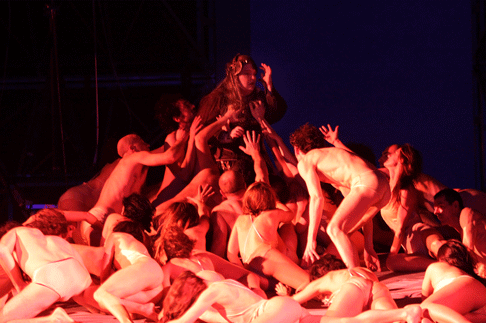
If the set and direction are the end of bewilderment, the reviewer is bewildered by the harmony between the stage, the pit and the voices. La Fura has been an earnest and successful effort to follow each and every note of the score.
As the triumph of love is the main theme of this Götterdämmerung, love itself is being rhapsodized in all possible combinations: conjugal love in the “day break”, wild sex (nearly a rape with coitus interruptus) in Siegfried’s approach to a sensual , and sex starving Gutrune, a full orgy in Brünnhilde’s rock, teasing petting in the scene of Siegfried with the Rhinemaden , lust for unsatisfied love by Günther, Hagen and Alberich . Again as love is at the center of Götterdämmerung as well as of the Ring , Mehta has a lyric approach to the score , quite different from that (very dramatic) of the Florence 1979-81 Ring. The Maggio Musicale Orchestra and Chorus responded in an excellent manner.
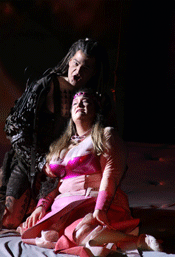 Also, both Mehta and La Fura have, at their disposal, a better cast of singers and actors than that of the 1979-81 when Jean Cox as Siegfried was already way over bend. Lance Ryan is well known to the American and German audience, but he has seldom sung in Italy. Notably, he has never shown his athletic qualities. In this Götterdämmerung, as soon as he is welcome to dinner in the Gibichung royal hall, the Canadian tenor, as any good red blooded but well mannered North American, takes off his dirty forest wilderness clothes to shower and put on a proper attire: his high “Cs” and legatos are beautiful under the shower and when , due to Hagen’s potion, tries to do it with Gutrune on the dinner table and in front of his hosts. He can even sing hanging by his feet in the confrontation with in Brünnhilde in the second act. And he can shoot an acute after another. Not a full heldentenor, but a very good tenor with a crystal clear timbre.
Also, both Mehta and La Fura have, at their disposal, a better cast of singers and actors than that of the 1979-81 when Jean Cox as Siegfried was already way over bend. Lance Ryan is well known to the American and German audience, but he has seldom sung in Italy. Notably, he has never shown his athletic qualities. In this Götterdämmerung, as soon as he is welcome to dinner in the Gibichung royal hall, the Canadian tenor, as any good red blooded but well mannered North American, takes off his dirty forest wilderness clothes to shower and put on a proper attire: his high “Cs” and legatos are beautiful under the shower and when , due to Hagen’s potion, tries to do it with Gutrune on the dinner table and in front of his hosts. He can even sing hanging by his feet in the confrontation with in Brünnhilde in the second act. And he can shoot an acute after another. Not a full heldentenor, but a very good tenor with a crystal clear timbre.
Brünnhilde is another North American , Jennifer Wilson, recently applauded as Isolde in Los Angeles. She is as overweight as expected by a Walkyrie and, albeit very good with the high tonalities, she has some difficulties in descending to low pitched tones. She masters the role technically by molding the use of her voice to fully explode in the final holocaust scene.
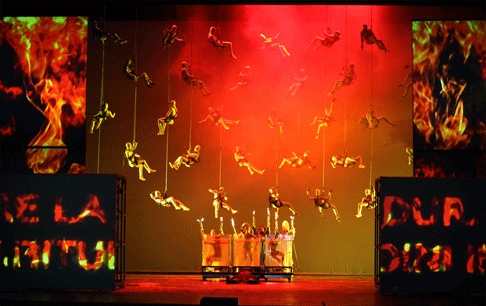
The Ghichung Kingdom is a modern Metropolis for rather vulgar nouveaux riches. In the smoke stocks of a declining industrial society, a ticker - similar to those of Cnbc or any other all news TV financial channels - reports the stock exchange news. Gutrune is a sexy lyric soprano (Bernardette Flaitz), Günther a well round baritone (Stefan Stoll), Hagen a deep basso (Hans Peter Köning), Alberich a less deep basso bordering on a baritone voice (Franz-Joseph Kapellman). Of all the other singers, a special mention is needed for Catherine Wyn-Rogers (Waltraute), the only semi-Divinity in this very human Gesmtkunswerk (total theater) centered on love.
Giuseppe Pennisi
image=http://www.operatoday.com/139-6241.gif image_description=
product=yes producttitle=Richard Wagner: Götterdämmerung productby=Lance Ryan: Siegfried; Stefan Stoll: Gunther; Hans Peter König: Hagen; Franz-Joseph Kapellmann: Alberich; Jennifer Wilson: Brünnhilde; Bernadette Flaitz: Gutrune; Catherine Wyn-Rogers: Waltraute; Daniela Denschlag: Die erste Norn: Pilar Vázquez: Die zweite Norn; Eugenia Bethencourt: Die dritte Norn; Silvia Vázquez: Woglinde; Ann-Katrin Naidu: Wellgunde; Marina Prudenskaya: Flosshilde;Nicolò Ayroldi: Ein Mann; Fabio Bertella: Ein anderer Mann. Orchestra e Chorus of Maggio Musicale Fiorentino. Zubin Mehta: conductor. Carlus Padrissa: stage direction. La Fura dels Baus: stage production.